The post Evolving forward: Advancing MiMEP in Hong Kong appeared first on Without Limits.
]]>Highlighted in every single Chief Executive’s Policy Addresses since 2017, the pre-fabricated modular approach as an innovative construction technology has been emphasized for Hong Kong’s development. This approach, using Design for Manufacture and Assembly (DfMA), has transformed construction practices over the last decade, driving efficiencies, fostering innovation, and enhancing safety.
With AECOM having promoted the use of DfMA-inspired prefabricated roof modules with pre-installed MEP for the Hong Kong Port of the Hong Kong-Zhuhai Macao Bridge, we were engaged by the Construction Industry Council (CIC) to develop an industry guideline on extending the DfMA approach into mechanical, electrical and plumbing (MEP) works, now known as multi-trade integrated MEP or MiMEP.
Released in 2021, the industry guideline Reference Material on Adopting DfMA for MEP Works encourages offsite prefabrication solutions, while fully harnessing digital tools such as Building Information Modelling (BIM). In the three years since, there has been a healthy development of MiMEP in Hong Kong. Application has been seen across a variety of government and private sector projects, while MiMEP was also highlighted as a key strategy to expedite housing supply in the Chief Executive’s 2022 Policy Address. However, technical, logistical and supply chain challenges still need to be overcome in order to drive further adoption.
3SS Smart Support solution to manage large MiMEP frames
Compared to traditional methods, MiMEP essentially reorganizes the construction process, replacing low-efficiency on-site construction with high-efficiency off-site construction. The idea is to use DfMA’s assembly line concept, combining parallel off-site and on-site construction with streamlined logistics processes, and ensuring full preparation for future maintenance.
MiMEP can significantly enhance productivity, work efficiency and quality, while improving workers’ safety and reducing site waste. However, since MiMEP aims to integrate multiple systems into a single, cohesive module, a more elaborate and robust concept is needed for transportation protection, on-site hanging and facilitating construction. AECOM has developed the Three SS (3SS) Smart Support solution to provide a framework that addresses these technical challenges and encourages the adoption of MiMEP.
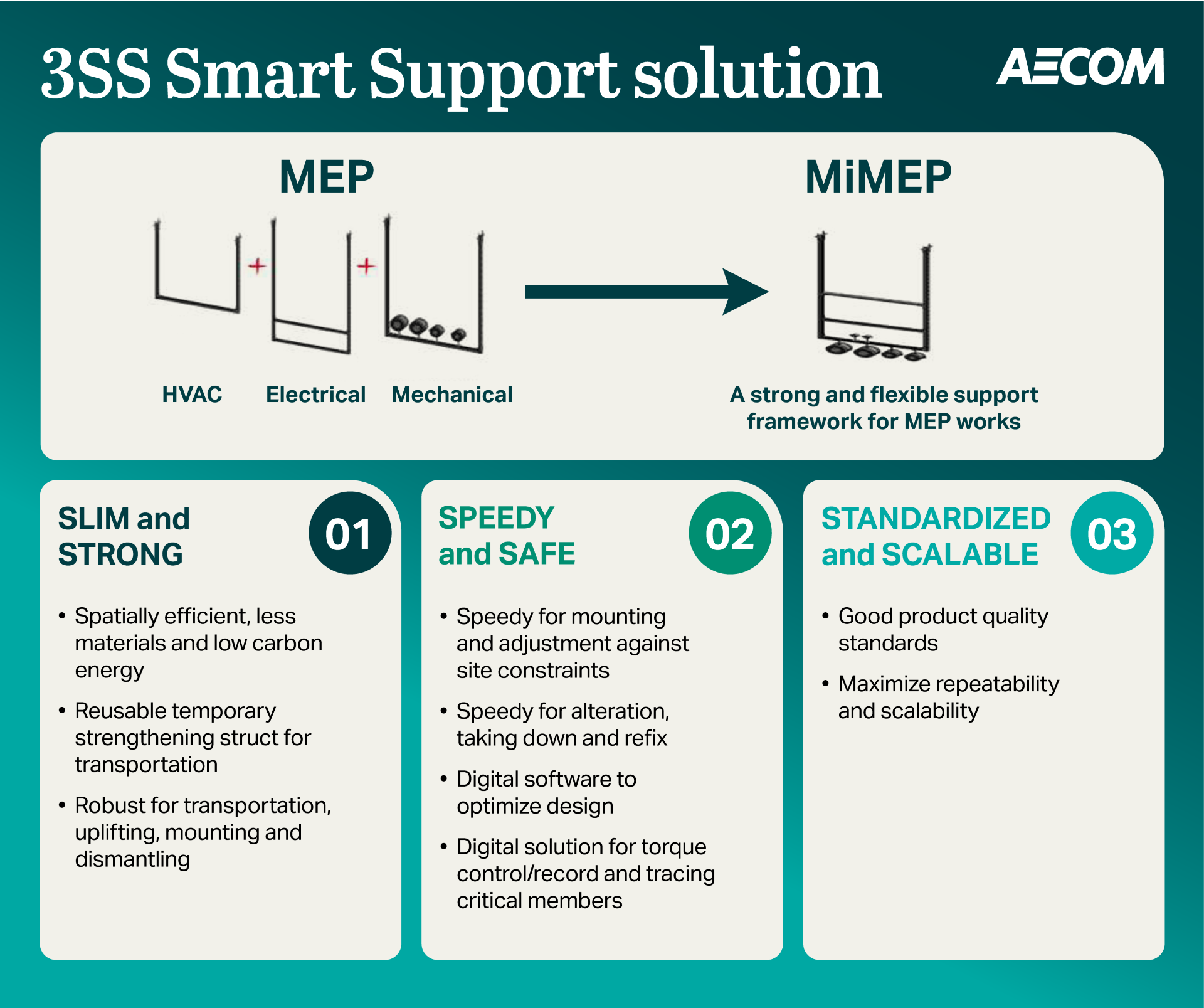
Tackling logistics issues through digital solutions and careful planning
MiMEP logistics are inherently challenging. Issues include costs, time, coordination of off-site/on-site aspects, finding suitable suppliers, transportation costs, and customs clearance. Nowadays, digital solutions have emerged to track logistics and ensure long-distance travel does not cause potential delays.
In Hong Kong’s West Kowloon Terminal Topside Development, AECOM was able to overcome construction difficulties by using multi-trade components in the tunnel connecting the topside development to an off-site seawater cooling system plant room, with logistics arrangements for installation pre-planned using 4D software.
However, more mature solutions are still needed to address certain issues when adopting MiMEP. For instance, the large size and weight of MiMEP modules can present a bottleneck for on-site logistics, requiring specialized equipment and careful planning.
Application of the 6Ps Framework to identify suitable suppliers
A solid base of suppliers is also crucial for further adoption of MiMEP. Supply chains in Hong Kong, the Greater Bay Area and further into Mainland China have emerged to meet this demand. Yet, the market is still developing as we now require a broader range of skillsets beyond just MEP, for instance in digital and logistics. Our 6Ps serve as a checklist to help make an informed decisions when selecting a suitable supplier:
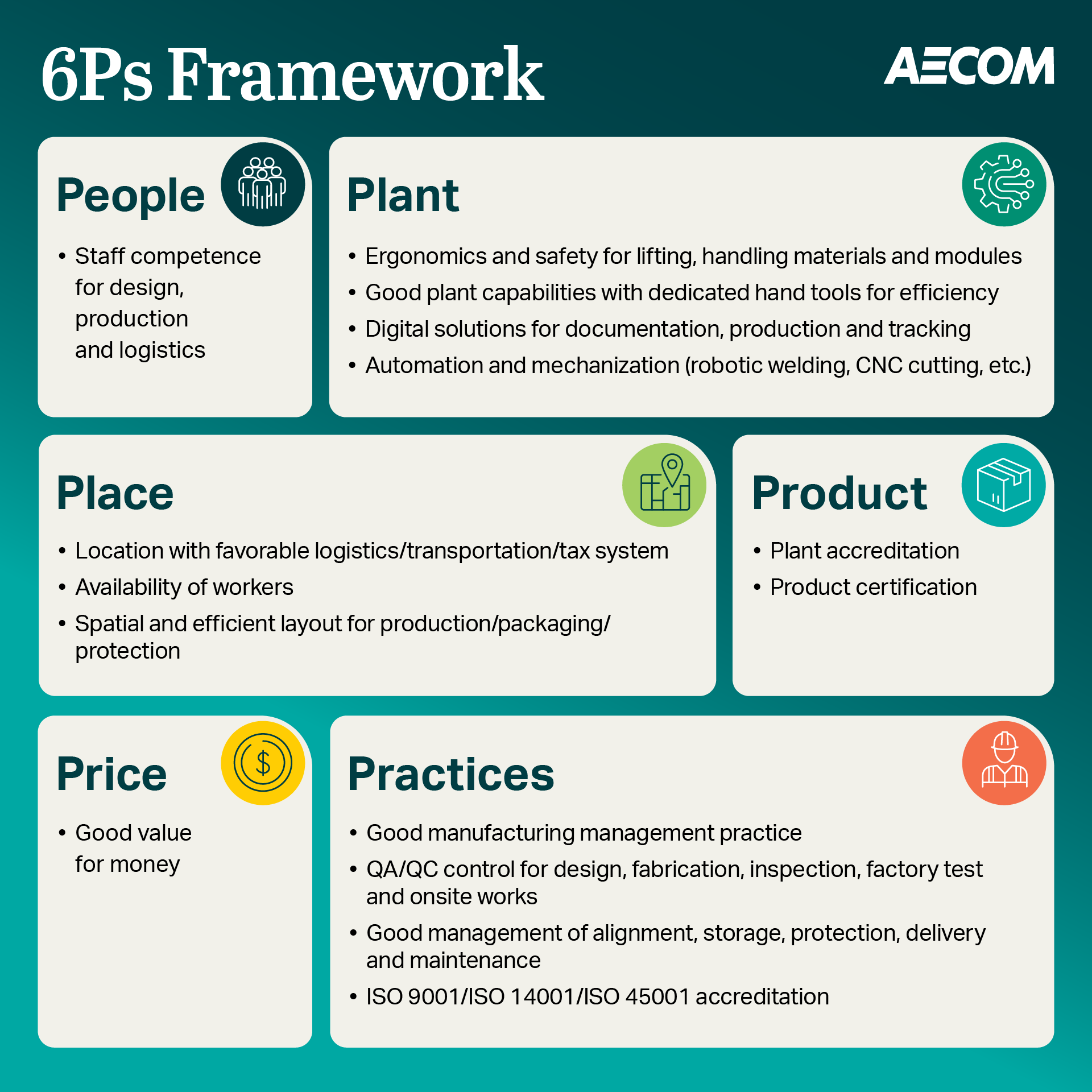
Advancing the MiMEP ecosystem
Three years after publication of AECOM’s industry guideline, both the public and private sectors in Hong Kong have shown a growing interest in adopting MiMEP. As it continues to gain traction in the industry, the concept will evolve and develop. There is no one-size-fits-all approach in this case, and stakeholders will need to identify project-specific drivers such as a client’s values and project KPIs, supply chain capability and degree of repeatability to create a viable MiMEP solution.
Our goal is to continue to facilitate wider adoption of MiMEP in Hong Kong by collaborating with industry partners. To achieve this, four steps are essential:
- Raise awareness through education and promotion
- Engage with stakeholders to create the demand
- Enhance supply chain collaboration/ecosystem
- Build up local capabilities and skills
By focusing on these steps, we can solidify MiMEP’s role in the Hong Kong construction industry, helping to enhance productivity, quality and safety, while achieving environmental sustainability.
The post Evolving forward: Advancing MiMEP in Hong Kong appeared first on Without Limits.
]]>The post Embracing the future of project delivery: the need for an integrated data management approach appeared first on Without Limits.
]]>Enhancing customer experience
Customer experience during project delivery is becoming increasingly important. Today’s customers expect greater transparency, intimacy, and collaboration. They seek a clear understanding of project progress, real-time updates, and a collaborative environment where their input is valued. Meeting these expectations requires an integrated system that provides seamless access to project data and fosters open communication.
Continued focus on sustainable outcomes
Environmental factors are gaining prominence in large, complex design and construction projects. Stakeholders are increasingly aware of the need to address environmental impact, social responsibility, and governance standards. An integrated project delivery system can help organizations incorporate sustainable and social considerations into every phase of the project, ensuring that sustainability and ethical practices are prioritized.
Leveraging artificial intelligence and advanced design tools
Artificial intelligence (AI), computational design, and parametric design tools are transforming the way design projects are executed. These technologies enable more efficient and accurate design processes, allowing for rapid iteration and optimization. A common data environment enables all disciplines to work together within a single federated model. This approach minimizes conflicts and rework, ultimately leading to faster and more reliable project delivery.
Contract models are also evolving, leading to shifts in risk profiles and the integration of design and construction phases. Modern contracts often require blended models that demand access to information and design details in new and innovative ways. An integrated project delivery system supports these evolving contract models by providing a unified platform where all stakeholders can access and share critical data, ensuring alignment and reducing the risk of miscommunication.
Embracing integration for success
To remain competitive, organizations must adopt an integrated project delivery system that connects data from every aspect of a project. This comprehensive solution merges design technologies, project management tools, document and content management, and geographic information systems (GIS) into a unified platform.
Utilizing technologies and program management tools
An integrated project delivery system revolutionizes the design process by enabling collaborative visualization, iteration, and refinement of project concepts. Stakeholders can work together in real-time, using advanced design tools to create and adjust designs collaboratively. This approach ensures that all disciplines are aligned, reducing conflicts and minimizing rework.
Project management tools within the integrated system support scheduling, resource allocation, task management, and cost control. These tools form the backbone of daily project workflows, enabling project managers to monitor progress, allocate resources efficiently, and control costs effectively. Real-time updates and progress tracking provide stakeholders with the information they need to make informed decisions and keep the project on track.
Moreover, centralized access to project documentation is crucial for fostering collaboration and efficiency. The document and content management functionalities of an integrated project delivery system offer intuitive search and retrieval capabilities, ensuring that stakeholders can easily access the latest information. This centralized repository streamlines communication, reduces the risk of errors, and enhances overall project efficiency.
Integrating GIS technology also provides powerful geospatial capabilities, allowing stakeholders to overlay project data onto geographic maps, analyze spatial relationships, and visualize the impact of location-specific factors on project performance. By integrating GIS with other data sources, the system offers a geospatial context that enhances visibility and transparency, enabling stakeholders to make better-informed decisions.
Looking towards the future
To thrive in this new era of project delivery, organizations must move beyond siloed processes and legacy technologies. By adopting an integrated project delivery system, they can unlock the full potential of their data, foster a collaborative environment, and drive successful project outcomes. This forward-thinking approach is not just a competitive advantage— it is a necessity for staying relevant and achieving excellence in the modern project delivery landscape.
The post Embracing the future of project delivery: the need for an integrated data management approach appeared first on Without Limits.
]]>The post Why buildings that live and learn will unlock a better future appeared first on Without Limits.
]]>Optimising sustainability and user experience
The recent generation of buildings has already implemented smart technologies, such as Internet of Things (IoT) sensors to gather environmental and system inputs. Aspects of the workplace environment, like air quality, benefit from these inputs, relying on a fine balance of systems driven by sensors and user comfort feedback.
Today, as we design the next generation of buildings, artificial intelligence is advancing smart buildings even further by automatically adapting a building’s systems using IoT insights. Data analytics and artificial intelligence are valuable tools in making informed decisions about building design, maintenance, and resource allocation.
There are many ways to maximise Environmental, Social and Governance (ESG) outcomes in smart building design, such as measuring embodied carbon in the procurement process and using Environmental Product Declaration information to source low-carbon technology solutions.
It’s important to consider how people are likely to use the building in the future, analyse the efficiency across a portfolio, and consider aspects like popular transport modes and the demand for car parking spaces, all of which can significantly impact a building’s footprint and optimisation.
For organisations, tools and technologies can improve people’s living and working space. Augmented reality, artificial intelligence, laser scanning, artificial hygiene, and circadian lighting can all be used to support health and well-being. Considered and implemented thoughtfully, these tools play a vital role in unlocking a range of sustainable outcomes and improving business performance while engaging people to work together towards a low-carbon economy.
However, systems selection at the design and procurement stages is key to seamless integration. A powerful master systems integrator is a critical success factor of any next-generation smart building. This delivers a fast network for the building occupants, the capacity, speed, and flexibility to integrate all the building’s systems, and better ESG outcomes, particularly when followed-up with reporting, learning and optimisation, AI-powered insights and predictive maintenance.
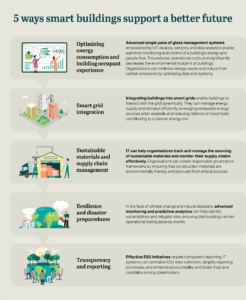
The intersection of IT and ESG in buildings presents an incredible opportunity to drive sustainable and responsible practices. The components of ESG are interwoven with IT solutions that optimise energy consumption, enhance occupant well-being, track material sourcing, enable data-driven decision-making, promote resilience, and ensure transparency.
Organisations that embrace IT-driven ESG initiatives in their building infrastructure are not only fulfilling their social and environmental responsibilities but also positioning for long-term success in a world where sustainability is paramount. As technology continues to evolve, IT will remain an invaluable tool in creating a better, more sustainable, and equitable future for all.
The post Why buildings that live and learn will unlock a better future appeared first on Without Limits.
]]>The post Five ways project managers can use data analytics to boost project performance appeared first on Without Limits.
]]>Given the speed with which technology and data legislation can advance and the plethora of off-the-shelf software that promises to revolutionise projects today, it’s no surprise that managers can struggle when choosing the most effective way to capture, store and visualise their data.
That’s why with a better understanding of the process and the efficiencies that data empowerment can bring, there are exponential benefits to be gained.
Here we share five effective uses of data analytics:
1/ Making data more accessible
For data specialists, interpreting vast quantities of data from tables and graphs is second nature. But for others – including project stakeholders – the information might not be so straightforward. This is where business intelligence (BI) tools for data visualisation can help.
When used effectively, BI visualisation allows your project reporting to be communicated in a clear, digestible format. As well as making data more accessible, these tools can improve collaboration between teams by providing a more integrated workspace – with bespoke dashboards for each stakeholder group or review session.
2/ Providing a single source of truth
As a project manager, the overall success of the project will ultimately fall on your shoulders.
Effective use of data analytics principles alongside your regular reporting can lead to a greater sense of control and improved accountability across the project team.
By utilising a single reporting dashboard suite, this removes the occurrence of rogue files saved to desktop, enables better protection via cloud storage, and ensures that data access is universal across the project.
3/ Adopting trend analytics to gain key insights
One of the most accessible data analytics principles to apply to project data is trend analytics. This is a strategy used to forecast future outcomes based on historical data.
Besides helping to identify positive outcomes, trend analytics can allow project managers to address issues before they escalate.
Furthermore, custom analytics within a digital report can be configured to automatically refresh each of these key metrics with each new data refresh – instantly generating a headline view of key performance indicators.
4/ Integrating data into a unified platform
With data often stored across numerous databases, software packages, and legacy company servers, reporting can often mean hours of copying, pasting, and formatting of slide packs.
BI software such as Microsoft Power BI or Tableau allow the user to load and transform data from a seemingly endless list of sources databases such as Azure.
Combined with a robust data model, this can allow comparison and analytics of datasets that would typically present a challenge.
5/ Early engagement means early results
The main challenge project managers face is trying making results happen quickly, especially if we are coming into a programme project in a troubleshooting role.
Once a project is underway, it can be challenging to devote time to adjusting processes and practices. Engaging a data specialist early and defining project-specific analytics outputs will allow for faster and more effective implementation of data-driven solutions. Stakeholders can expect more informed decision-making, increased efficiency, and better team integration from the outset – leading to improved outcomes and successful delivery.
The post Five ways project managers can use data analytics to boost project performance appeared first on Without Limits.
]]>The post Virtual Consultation Platform transcends boundaries and transforms collaboration appeared first on Without Limits.
]]>Last year’s theme focused on the acceleration of our digital delivery strategy, and the event brought together 100 AECOM leaders over two and a half days. The conference served as a catalyst for positive change, urging teams to embrace their roles as digital leaders within the company, share their own stories, and explore novel approaches to solving complex problems.

As part of the 2023 conference, our marketing and digital teams created an interactive virtual conference room, showcasing the event invitation, digital case studies and the ANZ digital microsite through our own Virtual Consultation Platform, a fantastic example of global collaboration using cutting-edge technology to deliver an engaging and innovative solution for attendees of the conference.
Our global community supporting the development of the interactive virtual conference room included the ANZ Clients & Marketing team, the New Zealand Visualisation team and the UK-based Virtual Consultation team. The teams worked closely together, leveraging inspiration and technology to create a stunning, high-quality product.
- Our marketing team drew inspiration from the nostalgia of 90s arcade spaces. The vision was a fusion of futuristic visualization with a touch of retro aesthetics, brought together with an overarching theme of ‘Digital Innovation’, setting the stage for a visually stunning and informative virtual space.
- Transforming this vision into a digital reality fell into the capable hands of our New Zealand-based visualisation team. They crafted a photo-realistic 3D model of the environment, bringing the arcade concept to life. The result was the AECOM-branded neon-lit arcade that forms the digital environment to the immersive virtual experience.
- The UK Virtual Consultation team took the render and incorporated the conference content, video, and other interactive elements into a full 360-degree immersive environment, available on all mainstream platforms and can be accessed anytime, all through our cutting-edge AECOM Virtual Consultation Platform. The result is a fantastic virtual room that goes beyond the limitations of physical spaces, providing conference attendees with a dynamic and engaging platform to connect, learn, and interact.
AECOM’s Virtual Consultation Platform
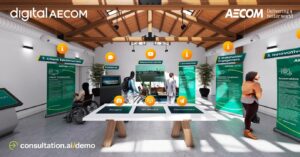
The virtual platform showcases Digital AECOM case studies from a number of projects and sectors, from flood modelling and data management to 3D modelling and AI. The room also showcased content from the conference keynote speaker, Dr Jordan Nguyen, an internationally renowned engineer, inventor and innovator.
Since launching in April 2020, our Virtual Consultation platform has helped reach millions of people during the pandemic and beyond. By replicating a consultation, exhibition or conference, our Virtual Consultation Platform can seamlessly display digital materials, including exhibition boards, maps, videos, virtual reality and sound demonstrations, in a dynamic and engaging way.
The virtual platform complements traditional methods to allow people who can’t or don’t want to come to traditional events to view the information in their own time from any device. You can read more about our Virtual Consultation Platform here: https://consultation.ai/demo/
The post Virtual Consultation Platform transcends boundaries and transforms collaboration appeared first on Without Limits.
]]>The post Unlocking the power of digital twins in airports appeared first on Without Limits.
]]>Airports across the world have already begun their journey towards establishing digital twins – many without even realising it. Spatial data development and data management practices are the foundation of fully realised digital twins, and airports have invested in GIS and BIM platforms for decades. Across the Architecture, Engineering, and Construction (AEC) sector, digital ways of working are becoming critical in creating and testing designs. AEC professionals regularly create digital replicas to virtually test their designs before initiating on-site construction, a vital practice within the confines of brownfield environments. This approach enhances safety, program efficiency, and budget management, and reduces operator risks, and is increasingly seen as an essential component of the AEC industry.
However, digital practices can taper off as we progress through the design and construction phases, particularly when the AEC teams no longer find immediate benefits. This creates a downfall for airport operators when transitioning into the handover phase. The digital replica, once indispensable for design planning, may not be consistently maintained throughout the construction, commissioning, and handover phases.
Through AECOM’s extensive global airport experience, we have observed many clients face these challenges with producing and maintaining digital twins. Each client presents unique requirements shaped by their existing progress and capital works program. Considering these specific requirements is crucial to enabling high-quality deliverables. We explore five key steps to ensure successful airport digital twin implementation.
1) Commit to the implementation strategy
Choosing a front-loaded, strategic approach to developing clear and consistent information requirements may take more time initially, but it promises superior long-term results. This approach is particularly beneficial for clients with a gradual increase in capital works projects and an engaged internal stakeholder team. Alternatively, an agile project-based approach offers quicker results by evolving information requirements through specific projects, allowing for more rapid adjustments and, crucially, the involvement of all relevant parties in defining requirements.
2) Elevate existing success
Often, we tend to focus on our shortcomings on the path to developing a digital twin. However, it’s equally important to highlight and support the outstanding accomplishments already taking place within our organisation. These successes are frequently driven by teams or individuals who work without a well-defined strategy. Recognising and supporting these contributors is vital for accelerating overall progress.
3) Set realistic goals and objectives
Start by identifying well-defined use cases and prioritise them based on the potential benefits compared to the effort required for implementation. This approach enables clear communication of the strategy to stakeholders, which is essential for effectively managing the necessary change.
4) Allocate resources for new roles
The transition to new deliverables will require additional support for the client team and the parties involved in providing the required data. A well-structured strategy should ensure that any additional resource investment pays off by reducing the duplication of information handling. Proper resourcing is especially critical in the initial stages to set projects up for success and ensure the delivery of required data upon completion.
5) Adapt the strategy
Recognise that the transition won’t happen overnight, and technology is continually evolving. Consequently, information requirements will also evolve over time to keep pace. Regular feedback from the entire stakeholder team and the providing parties is key to unlocking future opportunities. The critical task is continually monitoring and updating the strategy to reflect these changing needs.
Realising the Benefits
As Airport operators return to record levels of passengers, and significant capital works projects are once again in full swing, there has never been a more opportune moment to review your digital twin strategy. It’s the ideal time to ensure that you are harnessing the benefits of digital ways of working and maximising the potential of the data. The data generated today will form the foundation of how we operate and optimise these facilities into the future. It’s crucial for airports to seize the opportunity now to stay ahead in a rapidly evolving landscape and enhance their operational efficiency for years to come.
The post Unlocking the power of digital twins in airports appeared first on Without Limits.
]]>The post Unlocking the power of context: The crucial factor in communicating flood risk data appeared first on Without Limits.
]]>In this article, we explore five challenges related to communicating flood risk for major infrastructure projects, the current tools utilized to overcome them, and a contemporary solution for stakeholder engagement.
Five challenges when communicating flood risk
- Complexity of the information: Effective communication of flood risk requires a nuanced understanding of natural factors – meteorology, hydrology, topography and land use – and the impact of human actions such as urbanization, deforestation, and construction in flood-prone areas. Stakeholders have varying levels of knowledge and understanding of these impacts, so communicating this information clearly and concisely can be challenging.
- Uncertainty and probability: Flood risk assessments involve dealing with complex uncertainties and probabilities. Many members of the communities where we work are not experienced in statistics and complicated probability-based frameworks or know how to read and interpret flood model outputs. Advancements in flood modelling software and increasingly complex regulatory frameworks have widened the gap between our data and our ability to communicate it effectively.
- Stakeholder diversity: Stakeholders have varying levels of knowledge, interests, and priorities. Stakeholders may include individuals, landowners, developers, insurers, businesses, and government agencies. Tailoring flood risk communication to different stakeholder groups and addressing their specific needs whilst keeping this information concise is time-consuming and challenging.
- Communication channels: Identifying the most effective communication channels to reach different stakeholders and ensuring timely dissemination of information is critical. However, determining the appropriate channels and timing that align with stakeholders’ preferences and routines can be difficult, particularly when dealing with diverse groups.
- Emotional and psychological factors: Flood risk communication can evoke strong emotions and psychological reactions. Stakeholders may experience fear, denial, or complacency, which can influence their understanding and response to the information. Their own individual situations and experiences with flooding in the past can also significantly affect these emotional responses. Addressing these emotional and psychological factors is crucial for effective communication.
Context is key
In this digital era, our communities are provided with a myriad of ways to consume and engage with information. They now seek more detailed answers to complex problems, yet the overwhelming abundance of information we get every day restricts our attention to lengthy information. Having access to data and information alone no longer provides a satisfactory outcome. It’s, therefore, essential to understand the specific concerns and questions pertaining to each stakeholder group.
For instance, residents near a proposed infrastructure project may want to know how much deeper floodwaters might become on their property after the project is built. In such cases, it would be more effective to make comparisons using an actual historical flood that people can relate to rather than communicating a statistical and often misunderstood Annual Exceedance Probability (AEP).
Complex data requires a creative approach
Historically, the complexity of flood modelling data has kept this ‘black box’ of information largely hidden from the public. However, the increasing public scrutiny and community interest in improved environmental management are driving new and alternative solutions for improving the effective communication of this data and information.
Traditionally, hard copy, static flood impact maps are produced for major infrastructure projects to compare the existing case (current situation) with the developed case (after development) modelling results. Understanding them requires impacted landowners and other stakeholders to trawl through hundreds of static PDF maps to understand how the flood risk is likely to change and which changes exceed the flood performance targets. Then to find the direct impact on them, they must locate their property or area of interest. The lack of interactivity on these static maps and the disconnect with the technical reporting means they may not even be able to see the predicted impact in an easily digestible format.
To ensure these complex and convoluted concepts are communicated effectively to stakeholders, an engaging, intuitive, and interactive platform is required that can effectively navigate between technical detail, visualizations, maps, and graphics.
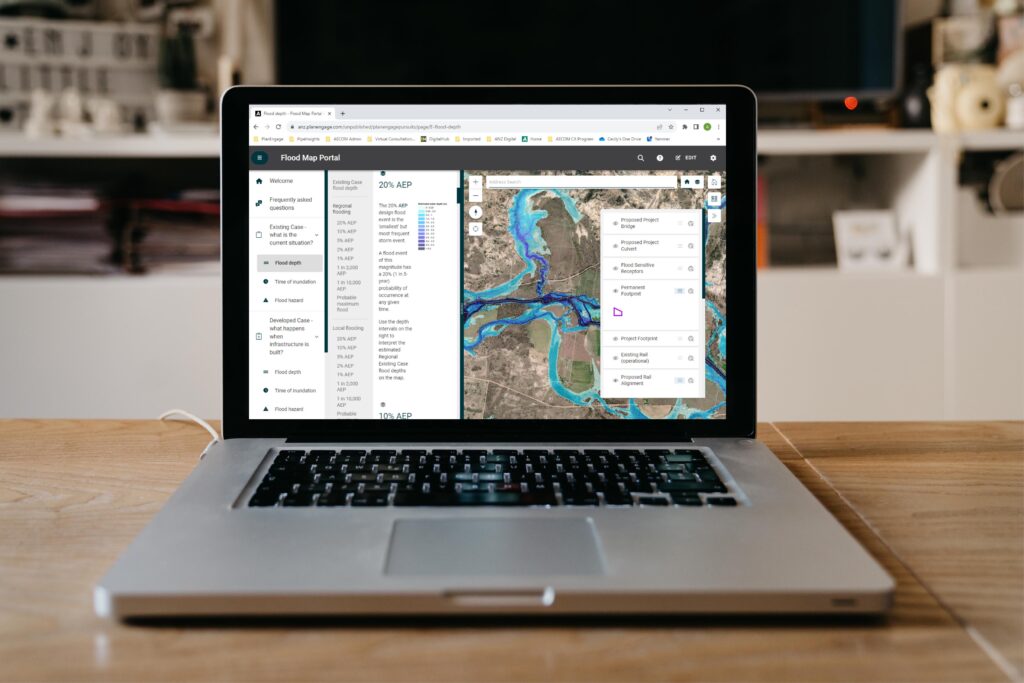
The optimal method for communicating flood risk data: An online, interactive, and visually rich platform
An online flood map portal provides site visitors with a visually immersive and user-friendly experience designed to cater to various audiences. It effectively communicates technical information such as flood mapping, making it accessible and understandable to the community, regardless of their level of technical knowledge. Allowing the community to search for their address and interact with an adjustable map to customize their experience of the information enables everyone to find the answers they require.
The Flood Map Portal, created by AECOM for a major infrastructure project, provides this enhanced experience for the community. Hosted by PlanEngage , the Flood Map Portal simplifies the creation of this style of complex and data-rich report into a visual and interactive online platform. It offers the appropriate level of technical content, interactive mapping tools, data visualization and online surveys to make data easier to search, understand and collect feedback from the community. This version of advanced data communication has proven to be a practical approach for presenting flood modelling and flood performance criteria assessment outcomes for this project.
, the Flood Map Portal simplifies the creation of this style of complex and data-rich report into a visual and interactive online platform. It offers the appropriate level of technical content, interactive mapping tools, data visualization and online surveys to make data easier to search, understand and collect feedback from the community. This version of advanced data communication has proven to be a practical approach for presenting flood modelling and flood performance criteria assessment outcomes for this project.
Additionally, text-based technical information displayed alongside flood maps makes it easy for users to access and interpret both types of data simultaneously. This has been a challenge in the past as flood maps and technical information were often presented separately in hard-copy reports with a fixed scale or required users to navigate between different pages, which can be difficult on a computer screen or hard-copy document.
PlanEngage allows flood management practitioners to transform complex modelling data and technical reports into actionable knowledge. This, in turn, empowers the communities we serve to understand and interpret the data, enabling them to make informed decisions based on sound judgment. Comments and reviews posted by users act as immediate feedback loops to the project team and drive further engagement and understanding.
allows flood management practitioners to transform complex modelling data and technical reports into actionable knowledge. This, in turn, empowers the communities we serve to understand and interpret the data, enabling them to make informed decisions based on sound judgment. Comments and reviews posted by users act as immediate feedback loops to the project team and drive further engagement and understanding.
During a community engagement event about flood risk, we saw first-hand the benefits of making flood risk data more accessible. We used a 3D experience from a digital twin to inform and engage vulnerable residents in a frequently flooded neighborhood in Australia. In doing so, we helped them to understand flood behaviors, gain their trust and explore ideas which help alleviate anxiety and address future flooding.
Overall, the online Flood Map Portal, significantly enhances transparency in the planning and development process, ultimately leading to the successful implementation of more resilient and impactful projects.
Final thoughts on flooding
With the technological advancements of digital modelling, AI, automated design, increased data analytics capabilities and cloud-hosted reporting and visualization platforms, the tools, and technologies to make this process more efficient and effective are now becoming readily available. How we use this technology to communicate flood modelling data more effectively is only just starting to be explored and provides an exciting opportunity to enhance this space.
We are presented with an exceptional opportunity to optimize the use and dissemination of flood modelling data to ensure that the infrastructure projects we design and maintain are more considered, better designed, and ultimately deliver superior outcomes for the communities in which they are located.
The post Unlocking the power of context: The crucial factor in communicating flood risk data appeared first on Without Limits.
]]>The post Designing the life science laboratories of tomorrow appeared first on Without Limits.
]]>The UK is regarded as a life sciences powerhouse. Medicinal and pharmaceutical products are among the country’s top five exported goods, and the nation comes second only to the US in terms of inward investment.
The UK government values the domestic life science sector at £94 billion, and estimates it provides over 250,000 high-skill jobs in fields such as drug discovery, diagnostics, MedTech devices and vaccine creation. It is an expanding science, encompassing fields such as AI, genomics, biomanufacturing, tech-enabled healthcare devices and personalised immunotherapies.
The ‘golden triangle’ of London, Oxford and Cambridge is home to some of the most significant and well-funded universities and research centres in the world – all of which demand access to best-in-class life sciences laboratories. Universities and businesses in other parts of the UK are also hungry for lab space.
What are the characteristic design features of laboratories?
Lab fit-outs typically consist of a physical laboratory space area where research is carried out and an office-style ‘writeup space’, for performing desk-based analysis.
However, unlike office spaces, there are no accepted guidelines, specifications or building standards for life science laboratories. Despite sharing many common features such as receptions, desk space and communal staff areas, and even though they are often based in the same building, laboratory occupiers generally have different needs to those of office workers.
Many specifications refer to BCO Office 2019 as guidance for the office element, with no real set guidance for the laboratory function.
Confusion is also rife in how to deal with what is included within the shell and core of the building, and what is required as standard within the tenant demise.
The way life science companies operate within a building is also evolving. The incubator model – common in the US – is now gaining traction in the UK. In this model, multiple fledgling start-ups work in the same building and utilise the same facilities.
This one-stop-shop concept provides flexible, low-cost lab space and support to develop early-stage research. In addition to shared services, incubators can provide support to access venture funding, legal and IP guidance and commercial mentoring.

Designing with a solutions-focused lens
Some features and equipment common to laboratories are standard parts of a lab fit out specification. These include fume cupboards, door seals or multiple door systems, and writeup space.
It is generally considered wise to keep laboratory and office writeup space adjacent to each other to encourage the cross-pollination of experiments, research, and reflection amongst peers. A typical lab/office ratio is around 50:50. In projects where labs and offices are kept separate from each other, tenants have reported difficulty in effectively collaborating.
The access requirements must be considered well before the installation phase of a fit out. Particularly large or unique pieces of equipment may require specialist installation or be difficult to transport, lift or move, or may need to be built in situ. In some cases, rooms or buildings are designed around a specific piece of machinery. This can add to the building’s weight and structural loading considerations, including anti vibration measures, plus floor-to-floor height.
The more specialist the equipment, the more likely the requirement to provide special measures to control the environment in which the equipment is to be located – for instance slab thickening for vibration control, dark rooms, and clean rooms.
In turn, room heights often need to be higher to accommodate additional MEP needs. From a safety perspective, labs usually require high levels of ventilation and in some cases, advanced air filtration. There needs to be more frequent air changes in a science facility compared to an office space.
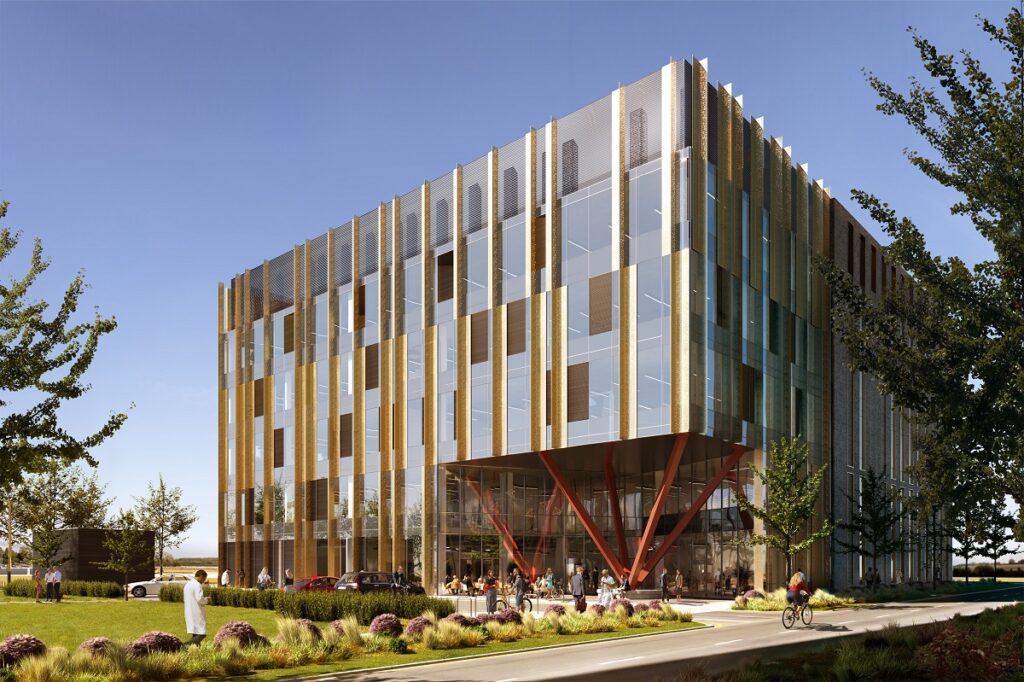
Prioritising health and safety is crucial
Containment levels – the ability of a lab to contain key biological hazards, genetically modified organisms and chemicals – must also be taken into consideration. These range from containment level 1 (C1), which represents the lowest level of risk, to containment level 4 (CL4), where highly dangerous or exotic microbes or pathogens are present, which currently do not have vaccines or antidotes.
At any containment level, laboratory doors/entrance systems need to be sealed and airtight. There are different ways to achieve this, but a common design is to create a double-door entry system.
The risk of containing potentially dangerous materials also makes building security a key design consideration. This extends beyond the labs themselves, to building reception areas and external spaces. Depending on the levels of security required, this will add significant costs on to a project.
Waste disposal is also key, and subject to hazardous waste regulations. Storage is also required for products such as consumables, glass products, personal protective equipment (PPE), and scientific literature. This can significantly increase storage space demands compared to a typical office.
‘Dry’ labs – used for computational science or advanced mathematical analyses – will require appropriate mechanical and electrical installations. Equipment such as 3D printers, powerful computers and lasers all demand specific power, safety measures, air supply controls, emergency power and humidity levels to function successfully.
Occupancy levels tend to be lower than typical office standards, between 15 – 18m2 per person, which impacts key services such as WC/shower provision and lift capacity.

Meeting the growing demand for lab space
The sector is a hot asset for private investors. A record £2.5 billion in venture capital (VC) was invested into private UK biotechs in 2021: a 79 per cent increase on the total raised in 2020. Overall, this signals that life science companies in the UK are now strong targets for both state and private capital and suggests demand for lab space is unlikely to abate in the short term.
As new science clusters emerge outside of the golden triangle, major new projects are springing up around the country, with big-name international businesses making the UK regions their home.
Life science laboratory fit-outs must be adaptable and able to meet the needs of biotechnology start-ups, which are by their nature nimble, ambitious and fast-growing. They demand high-tech, high-spec working environments where they can meet and collaborate with their peers.
Strong sustainability credentials are also key. The challenge for the design and construction industries is to keep pace with the scale and ambition of the life sciences sector – creating laboratory spaces that help accelerate and support scientific progress.
Cost model: Laboratory fit-out
We have built a cost model for a fit-out to a newly built office/laboratory building, from shell and core in central London. The building has approximately 100,000ft2 of net internal area, with an assumed typical floorplate of 50 per cent offices, 50 per cent wet CL2 laboratory. The main floorplate has been assumed to be divisible by four tenants per floor. The design of the building assumes a 6.9m x 9m structural grid.
You can download the cost model here.
This is an abridged version of an article that was first published in Building magazine. You can read the full article by clicking here.
The post Designing the life science laboratories of tomorrow appeared first on Without Limits.
]]>The post Digitizing design review appeared first on Without Limits.
]]>Carolyn Stegon, AECOM’s U.S. West region PPM digital lead, manages a digital plan review division that has launched work flows for clients to enhance project delivery success.
With hundreds of reviewers providing thousands of comments addressed on scores of reams of paper plans, traditional design review is a necessary but onerous step in the design process — one that calls for collecting, tracking, adding and reconciling seemingly infinite amounts of data and comments for each review phase.
A new digital solution I developed while working for our AECOM clients is revolutionizing design review procedures by better coordinating information while reducing time, expense and re-work — with the ultimate goal of streamlining internal agency and government efforts.
The start of something new
In 2010, I began helping to manage design reviews for one of AECOM’s major California clients. As a structural engineer with a decade of experience, I had a firm understanding of the technical review process and knew it could be time consuming and challenging. My engineer brain told me there had to be a better way. How could the process be streamlined?
I was introduced to a software platform that provided flexibility and organization that was in use by the client. With some adaptation, I customized and developed the software developing it so it provides an efficient digital design review platform that our clients could use to manage their projects. With the initial success of this review platform, I gradually introduced this new solution to some of our other clients. Success built on success and eventually I was approached by other clients to revise their design review process and began to lead an AECOM team that customized software solutions tailored to each of our clients’ needs. In some cases these newer clients were using the same software as our initial clients, in others we introduced clients to this software and in yet others we adapted other software to meet their requirements.
The importance and usage of a digital review system
Our team is all about developing and implementing a digital review system that works best for every client. Design and implementation typically involve an eight-step process encompassing a client working group, understanding and building client workflows, building the digital platform, establishing building procedures, providing formal training, receiving and then incorporating training feedback, and finally integrating the system into the client’s office. This last step includes providing project support, maintenance and staff augmentation as needed.
One key to developing the system is establishing a working group that incorporates decision-makers and subject matter experts. As a team we work to engage the right people up front. This advances the process by providing insights on work scope, goals and current positioning while delivering strategies that manage specific organizational challenges.
As its popular rises, so does the needed training and guidance
We develop hands-on supportive training that includes varied exercises and chaptered training videos. Our team also provides step-by-step procedures that include screen shots so reviewers fully comprehend their role in the design review process. As training progresses, we work with staff, helping them gain familiarity with the system by establishing a “sandbox setting” a demonstration project where they can practice using the platform. We also provide guidance on active projects.
Our involvement continues until clients are comfortable with the new solution. Our follow-up always includes a feedback survey and direct contact information for future assistance.
The nitty gritty: How does the system work?
Plans are uploaded as PDFs. The packages include specifications, calculations and any other information needed for review. Submissions can be done from an office or from home, with all reviews, back checks and approvals completed digitally. We invite reviewers to the digital space, where everyone views the same plans at the same time, working live in the space. This real-time collaboration enables our clients to communicate with project teams across multiple entities. We set up menus that document information and enable the originator, architect, engineer and other team members to see, sort, and more accurately respond to and reconcile comments. Plans may be digitally resubmitted and plan originators are able to obtain their permit digitally.
A record of success and a hopeful future
Now, 12 years after the first program, our services are evolving to become even more efficient. We have delivered customized design review systems to more than 30 clients, including the Division of the California State Architect, which reviews US$6 billion in construction plans for all California K-12 schools, community colleges and other state owned and leased facilities. We also work with the City and County of San Francisco and the Los Angeles Unified School District, and we use digital design reviews internally as part of our ISO 9001: Quality Management System certification.
To date, the AECOM team has helped Design Review Teams, including Permitting Agencies, cut down the average time required for review by 10-20 days, equating to tens of thousands of dollars in productivity increases. Additionally, we have helped Document Originators drastically reduce their paper and shipping costs overall. And the rate of adoption is only going up. We expect to work with 25 more clients in the coming year, furthering the efficiency of the design review process.
The post Digitizing design review appeared first on Without Limits.
]]>The post Automation lives: transportation agencies can spark AV advancement appeared first on Without Limits.
]]>Looking back at 2022, we saw the wrap of several organizations focused on the deployment of automated vehicles (AVs) with the closing of Argo.ai being the most recent. The combined forces of inflation and potential recession have driven up the cost of investment funding, and the United States is facing intense global pressure related to the development of automation. Vehicle automation also has the additional burden of being a safety-forward technology and safety solutions have traditionally shown a lower return on investment. This economic environment is leaving a strain on start-ups entering the market as well as organizations currently operating in the AV market.
Where does this leave automation? How can AVs prove their safety reputation while delivering on their promising investment to market? More importantly how do we continue to advance a technology and strategy that can help us tackle the significant loss of life caused by our existing modes of transportation that connectivity and automation could help solve.
Continued investments from global giants like Google’s Waymo which recently launched full-fledged robotaxi services in Phoenix, GM and Cruise which launched commercial services this last fall, or Baidu and Pony.ai which have won the right to deploy automated taxis in Beijing point towards a continued growth in a tightening global market.
Infrastructure owners and operators (IOOs) could equally have a significant investment in how to accelerate automation. Over the past few years, IOOs have worked to find their role in the deployment of automated vehicles. For the past decade, AV manufacturers have consistently messaged to IOOs that their vehicles are able to function in environments built for human drivers; however, minor adjustments to the infrastructure, particularly in the form of extra-vehicle situational awareness provided via communications, would allow for AVs to function more optimally. AV operators have explained that infrastructure consistency is important providing an environment that minimizes conflict with other road users. Until now, IOOs have not had a significant role in the deployment of AVs.
What if IOO’s and the AV industry could invest together to identify a set of minimal functional requirements for automation, better accelerating the safety frameworks for deployments, and thereby support automation developers and operators during a time when their funding is tight?
There are a handful of AV operational needs that are common across most platforms and approaches. If IOOs could develop some of these common factors, AV developers may be able to use their limited funding for other automation development. Equally IOOs would be playing an investment role in accelerating the deployment of safety benefits brought by the automation technology.
Some of the key areas of cooperation and support from the IOOs may include:
- Localization support
- Object detection and classification
- Common elements of path planning – such as sparse high-precision GPS waypoints, and high definition (HD) mapping.
If the AV industry can harmonize on these attributes across operational design domains (ODDs), AV developers may use investments to support more specific automation capabilities required for that developer’s specific business needs.
Localization and mapping
Many IOOs are considering creating high-definition maps of their geographies and several are considering integrating these with digital twins that also allow the IOO’s to convene digital policy, rules of the road and insights. As part of their efforts to improve safety in Utah, Utah Department of Transportation has already created HD maps of the entire state. Not all AV operators or designers use mapping the same way, and most AV OEMs create their own maps. If IOOs were to undertake an effort to understand the minimal set of data attributes needed for these maps, there may be opportunity to provide some harmonized basic mapping protocols that could be used by AV operators. If IOOs can increase safety with an investment in mapping, that may also allow AV operators to invest in other areas of operation, thereby proliferating safety and mobility improvements and improving automation technology.
IOOs should also work with the AV industry to determine what information can be shared from the industry back to IOOs if, for example, minimal map data is generated and shared with the AV industry, perhaps the industry could reciprocate with high-precision GPS corrections to the position of map elements. A thorough understanding of potential shared data needed to support automation could also be a part of an IOO effort to create digital twins of infrastructure. If an IOO can work with AV operators to understand data needs, digital twin design can be harmonized to accept and use data from vehicles.
Harmonized asset data
Roadway assets, specifically lane markings, signage, and traffic control devices, are not the same throughout the world. If IOOs can work together on developing and approving a harmonized dictionary for roadway assets and create a data exchange for this information, this could enable safety capabilities of AVs. This concept is already being pursued in the Department of Transportation Work Zone Data Exchange (WZDx), and for other infrastructure-based information such as signal phase and timing (SPaT) through the USDOT Joint Program Office (JPO) Operational Data Environment (ODE). Expanding on the WZDx idea, AV truck operators have also requested a Weigh Station Data Exchange (WSDx), which is another area where IOOs could add a spark.
Likewise, precise localization is a challenge for both automated and connected vehicles, specifically in “urban canyon” areas where tall buildings inhibit direct line of sight to GPS satellites and the GPS signals are reflected. Tunnels also provide a specific challenge for automated and connected vehicles for blocking GPS entirely, and due to the extreme lighting contrast for machine vision systems when entering or exiting a tunnel. Even in the complete absence of GPS information, AVs have the benefit of numerous onboard sensors, which are used to provide precise localization data to AV systems, such as the path planner. However, the effectiveness of this is tightly coupled to the algorithms used within the AV software stack. The USDOT-sponsored connected vehicle deployments have shown significant challenges in urban areas with tall buildings, specifically in New York City. In that pilot, the noisy GPS data was addressed using a novel method of measuring time-of-flight from Roadside Unit (RSU) to offset GPS signal error and verified using a vehicle mounted laser pointer. This would be possible by precisely measuring the GPS position of the RSU, which can be transmitted to On-Board Unit (OBUs) or stored in an onboard map of the AV or CV system. This is another example for how automated and connected vehicle systems can inherently improve each other, and how IOOs may be able to better support automation.
Like the RSU solution NYC used, GPS corrections can also be provided using a technology called real time kinematics (RTK), which uses a precisely positioned base station and broadcasts a correction that devices can use to overcome the error in the GPS signal. IOOs could provide something similar as a service to augment GPS precision equipment, which may include any kind of roadside equipment that is able to be precisely located and transmit a simple message with its location and a timestamp; however, regardless of the information an IOO is able to provide, the automated or connected vehicle devices will still need a minimum level of capability to process the data available effectively.
Path planning
Path planning is one of the fundamental components of an AV. In essence, this function is responsible for evaluating all available paths the vehicle could take in both the short-term and long-term planning horizons, and then selecting the “best” path. This occurs many times each second for short-term planning, which allows a vehicle to correct for small deviations in the vehicle’s position versus its previously planned position, and to react to immediate or predicted hazards that have been detected by the AV’s perception pipeline. Long-term path planning is akin to route planning and may never be revaluated once a route is set; however, a flexible path planning architecture will have the ability to replan a route based on unforeseen circumstances. To the extent an IOO can support fundamental path-planning which is something AV developers could potentially share.
One of the limitations of today’s AV systems is their inability to drive on roadways that have not been previously mapped by the AV developer using proprietary methods and data structures. This limits scalability and operational flexibility, but according to the previous mention on minimal map data requirements, IOOs could provide a sparse GPS waypoint data layer, accessible through a permissioned API for example, that would provide the AV developer with an idea of the contours of the roadways that a new route could be created within their system. The first time a vehicle travels on a new roadway using only the sparse GPS waypoints, it could proceed more cautiously relying more on its onboard sensors to navigate the environment, but as its traversing this new route, it can be recording all the data needed for the AV developer to create its own version of a map. The AV industry could then contribute back to the IOO information such as corrections to the sparse waypoints, further improving the accuracy of these, and expediting the use of the roadway for others in the future.
Together IOOs and the AV industry have an opportunity to use ingenuity and transferable solutions-thinking to integrate data, systems and mapping that can improve the safety ROI needed to ensure the livelihood of the AV market. Investors, developers, public and private organizations all should be working together to enable the future of automated transportation.
The post Automation lives: transportation agencies can spark AV advancement appeared first on Without Limits.
]]>The post Attracting and developing the next generation of engineers appeared first on Without Limits.
]]>It’s no secret that for many years, there has been a shortage of engineers around the world. A number of factors, including an increasing aging workforce and lack of interest, have been attributed to the declining numbers. In Hong Kong, it’s facing two additional conditions with the relocation of experienced engineers overseas and new graduates pursuing employment elsewhere rather than locally.
However, the shortage is not because of the absence of opportunities. In fact, under the pandemic, many governments are looking to invest in infrastructure projects to boost their economy and enhance resilience. In Hong Kong, there are ambitious plans for the future development of the city targeting increasing housing and infrastructure with the Northern Metropolis and Lantau Tomorrow Vision initiatives.
I believe the issue is that we need to showcase to more people, especially students, the exciting opportunities available in the engineering field and how the work contributes enormously to benefit their communities. When students are asked about their ideal occupations, their first choices are usually doctors and lawyers. They seldomly think of engineers as much of their work happens behind the scenes. This is especially true for those in the geotechnical discipline where projects are underground and not necessarily as aesthetically attractive as say a towering skyscraper. However, that doesn’t make their work any less important.
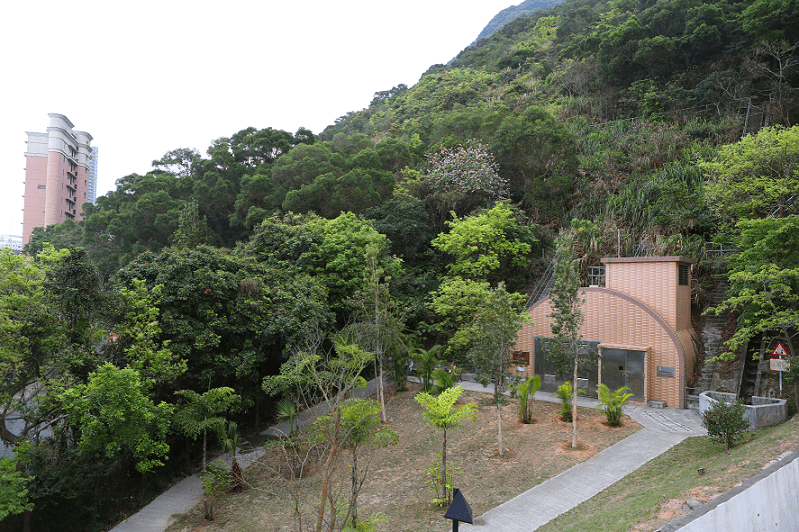
A good example is the Po Shan Drainage Tunnels, an innovative groundwater control system built underneath the hillside of the Mid-Levels areas of Hong Kong which offers better control of groundwater levels through a pair of drainage tunnels, 172 sub-vertical drains and an automatic real-time monitoring system. This wonderful piece of engineering work is almost invisible from outside, but it’s critical to reducing landslide risks and protecting the community. Geotechnical engineers are integral in safeguarding the public, whether it’s against devastating natural disasters, or ensuring the safety of a towering skyscraper through the design of a secure foundation to support the building above.
Both companies like AECOM and professional institutions have important roles to play in attracting and developing engineers. AECOM has the unique advantage of offering engineers of different disciplines ample opportunities to work on world-class projects around the world. Many of today’s engineers are excited about the prospects of working on international mega-projects such as NEOM in Saudi Arabia. Meanwhile, professional bodies can help raise the profiles of engineers and build up the image of the profession through outreach activities. In Hong Kong, the Hong Kong Institution of Engineers (HKIE) is one of the largest professional bodies, and in my new role as the Chairman of the HKIE Geotechnical Division, I’ll be actively working with its members to recognize and promote the technical excellence and contributions of engineers to the community.
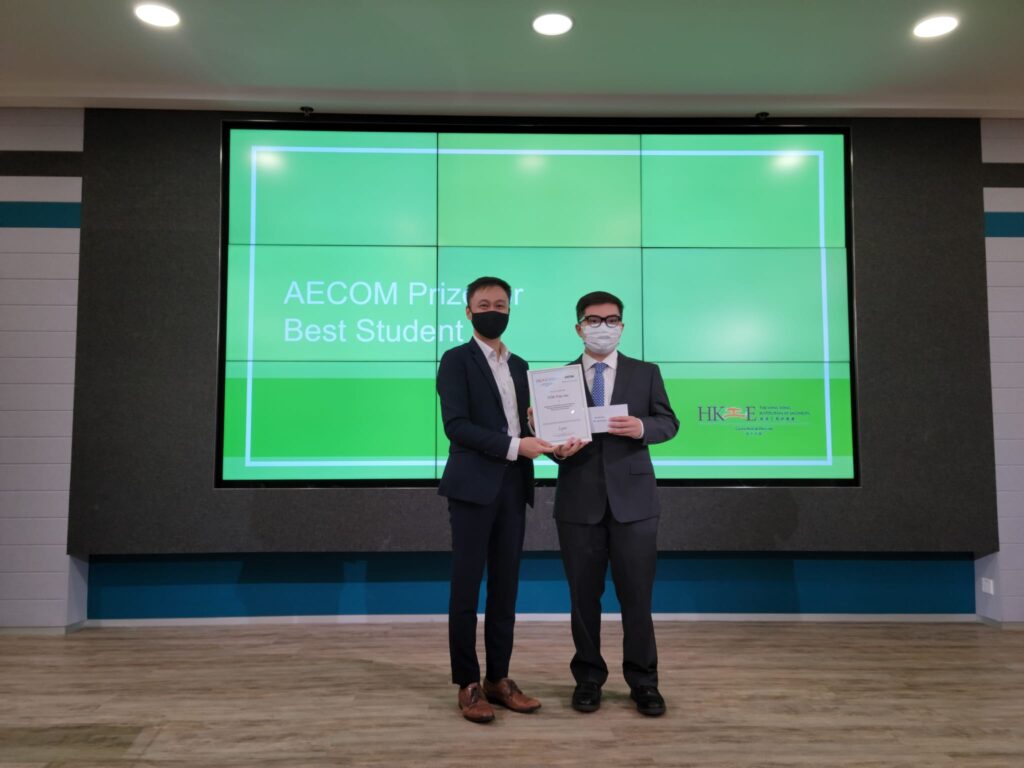
In addition to attracting more talents to the sector, nurturing the current pool of young engineering professionals is just as important. The declining numbers of experienced engineers offers them great opportunities to advance their careers, but some might not be equipped to take on more senior roles or responsibilities. Therefore, it’s up to the more senior engineers to spend more time in supporting the development of the next generations of engineers.
If the shortage of engineers continues to increase, it will certainly affect the delivery of various government and private projects. And if certain projects such as those to increase housing do not come into fruition, it can result in a chain of events that negatively affects different communities.
As someone who has been in the geotechnical engineering discipline for around 23 years, I still find it a very fun job as we are always dealing with uncertainties and complexities. Each project that we work on is unique as no two are the same. When we come to work every day, we are facing new challenges, which can be tough, but also rewarding. To me, engineers are unsung heroes whose contributions span from laying solid foundations for buildings and infrastructures to building safe tunnels through mountains and across the sea to ensuring public safety from different hazards such as landslides and flooding. There is a great sense of satisfaction and mission from this field as your work delivers positive impacts to your community and many others.
Johnny Cheuk is AECOM’s vice president, Geotechnical, Hong Kong, and Chairman of Geotechnical Division at the Hong Kong Institution of Engineers.
The post Attracting and developing the next generation of engineers appeared first on Without Limits.
]]>The post Online review tools mean better outcomes for infrastructure appeared first on Without Limits.
]]>Despite clear public interest in speeding the delivery of infrastructure improvements in the United States, it can take as many as 4½ years on average to receive environmental approvals that clear the way for major federal projects.
The Infrastructure and Investment Jobs Act (IIJA) establishes an approach to reduce these delays, and other permitting reform efforts are being pursued by government to deliver needed highway, rail, water, new energy and utility projects more quickly. At the same time, new cloud-based, interactive digital platforms like AECOM’s PlanEngage can be influential to help reduce by half the cumulative review time and improve transparency and public engagement. In fact, lawmakers in Congress are considering policies to encourage the use of digital tools in the review process.
Making regulatory documents more accessible
While the review requirements set out in the National Environmental Policy Act (NEPA) are critical to protect communities and habitat, a combination of factors over time has combined to extend the environmental review process – leading to costly delays and even dooming worthy projects. Environmental Impact Statements that were as once as short as 10 pages now average 600 pages, plus appendices that typically exceed 1,000 pages. Understaffed regulatory agencies often working across multiple jurisdictions and juggling input from the public, consultants and other stakeholders can bog down under the sheer weight of the review process.
Online digital platforms like PlanEngage essentially make NEPA documents more accessible, expanding stakeholder engagement and transparency, while enabling interactivity and edits in real time between regulatory agencies and the public that can speed up reviews.
“Delivering an ambitious infrastructure program requires a new approach – one that not only promotes engagement but also decreases the time required to make decisions on transportation projects that increase accessibility for all while decreasing our carbon footprint. Online, interactive digital solutions like PlanEngage will be essential to deliver these projects on task and on time with better outcomes for all.”
-AECOM
How PlanEngage made collaboration easier in Arizona
This was the case in Arizona where PlanEngage was first used by the Arizona Department of Transportation and the Federal Highway Administration (FHWA) during review of a 280-mile interstate highway segment between Nogales and Wickenburg. Instead of navigating dense, static, two-dimensional PDF documents, the platform allowed users to search headings and subheadings through a navigation bar and provide input. Readers could pop out graphics, see photos and visualizations in a separate window on their devices, and provide input.
In addition to promoting more efficient reviews, online digital platforms allow for better collaboration between agencies that can identify and resolve conflicts earlier in the process, which also reduces the number of formal comments on the draft EIS. In the case of Arizona’s I-11 expansion, it also unlocked new opportunities.
Arizona officials said the results achieved through the interactive process will guide their efforts on future studies.
With as much as $1.2 trillion in new federal infrastructure spending hitting the market, and greater demand by the public for input and more equitable ways to deliver it, the timing is right for increased uptake of online digital platforms. In a process where debate is limited to formal written submissions or public hearings, interactive, mobile-phone friendly documents and engagement, can draw higher levels of interest, reach a broader audience and allow for a wider diversity of voices in real time.
What’s more, officials say, is that better public understanding of projects leads to more substantive comments, less ambiguity and fewer delays or challenges related to not being able to find information in a timely way.
“The interactive EIS was a first for ADOT [Arizona Department of Transportation] and the State of Arizona, and it was a huge accomplishment for the I-11 study team,” said. “It allowed ADOT and FHWA to explore a virtual method for virtual public involvement while providing tools … to help the public fully understand the final Tier 1 Environmental Impact Statement document. The success of the interactive EIS and the number of views it has received has clearly demonstrated its value to ADOT and the necessity to implement this kind of interactive tool for other studies.’’
Steven Olmsted, Arizona Department of Transportation program delivery manager
Reducing costs, speeding up delivery
The core goals of environmental review and public participation remain as important as ever in the review process. Delivering an ambitious infrastructure program requires a new approach that aligns with the original intent of NEPA requirements and helps get projects off the drawing board.
A 2015 analysis prepared by Common Good, a nonpartisan reform coalition, found that a six-year delay in starting construction on public projects cost the nation nearly $4 trillion, a sum far in excess of the amount needed to modernize America’s infrastructure. Today’s inflationary economy has already begun eating into the spending power created by IIJA and client project decision-making.
Regulators and clients alike can play a role in encouraging innovation and moving from the approach of previous generations for environmental reviews to an interactive, cloud-based platform approach appropriate for 21st century infrastructure. The outcomes can lead to better projects delivered faster and more economically, while ensuring the environmental protections that keep our communities safe and thriving.
The post Online review tools mean better outcomes for infrastructure appeared first on Without Limits.
]]>The post In the development of autonomous transportation, we’re all apprentices appeared first on Without Limits.
]]>When the producers of one of the BBC’s biggest shows called and asked whether they could feature autonomous pods from a project we’ve been recently working on, along with our colleagues at Westfield Autonomous Vehicles, we were initially hesitant. It’s not that we didn’t want to raise the profile of future mobility, but when we say that profile would be in the hands of nine candidates vying to be Lord Sugar’s apprentice, you’ll understand why.
Nevertheless, we decided to go for it, with the candidates being tasked to brand their own autonomous pods and much of the filming undertaken at AECOM’s London Aldgate offices. Like most viewers, I cringed my way through the episode as the candidates pitched their branded pods to a range of potential clients – and very good sports – including AECOM clients High Speed 2 (HS2) and Network Rail, with some success.
But what happens on The Apprentice stays on The Apprentice. While the pods pitched by candidates will, of course, never see the light of day at HS2 and Network Rail, it does raise the question of whether autonomous pods will soon become a common part of our transport infrastructure?
The episode came about after the show’s producers spotted the AECOM-led Capri Mobility project on the news, which was a research project looking at how autonomous vehicles could work as part of a wider transport system.
Autonomous vehicle technology is already here and well developed, but there are a range of social, legal, and technical issues that will make their wider deployment more challenging to achieve. So, what did we learn from the candidates and how far off the mark were their brands?
One of the most important barriers to consider is public perception. Industry will need to understand their fears, concerns, ideas and aspirations to ensure future services are designed to meet their needs and make them feel safe. What the show demonstrated was that the perception of how pods could potentially be deployed was diverse – from a green transport solution to an experiential activity.
A hugely important discussion about how autonomous transport interfaces with society and technology is currently unfolding and ongoing. The research we’re undertaking in this area has been crucial, as it helps us understand what we need to do, as an industry, to make this technology applicable to real life. These decisions about real life application have to grapple with answers to questions such as what are the right priorities for which types of roads, considering how best to balance the needs of pedestrians, cyclists, autonomous vehicles such as pods, and freight?
These answers will, in turn, raise the question of where investment in autonomous pods is best placed. For example, if its focus is in taking carbon out of the ‘last mile’ of journeys, should we, as a society, pursue in preference current policy to promote active travel modes increasing walking and cycling? As we evaluate the viability of investment returns, we may start to see the focus shift towards other challenges such as the potential to aide freight decarbonisation, or improve the customer experience of mass transit.
“We may start to see the focus shift towards other challenges such as the potential to aide freight decarbonisation, or improve the customer experience of mass transit.”
Societal reactions are often shaped by the media response and decisions will feed into government policy around the roll out of this technology. Mapping the algorithms that control the vehicles with a clear and consistent policy approach will be crucial to enable these systems to realise their potential. Last night’s episode was a tiny part of that discussion, but it will certainly help raise awareness of the debate around how we’ll get around in the future. In the same way those of us of the Tomorrow’s World generation recall the technology introduced to us by Maggie Philbin, it will be interesting to look back on this episode in a decade’s time and see how much it has dated.
In the episode the candidates were tasked with the fun element in the evolution of our deployment of autonomous vehicles, exploring the potential markets. At AECOM we’re working at a wider and deeper level, considering the societal and technological challenges and researching the interface of this technology with the market and regulation. We’re playing a pivotal role in developing our understanding of what we need to do to put autonomous vehicles into operation.
But we’ve got more in common with those on The Apprentice than you might think. Just like Lord Sugar, we’re looking for a diverse range of the brightest and most innovative minds to join us and help society navigate what the future might look like. And just like the candidates, there’s still so much to learn about the part autonomous vehicles will play in our mobility future, that it’s fair to say we’re all still apprentices.
This is an edited version of an article that first appeared in New Civil Engineers online edition.
The post In the development of autonomous transportation, we’re all apprentices appeared first on Without Limits.
]]>The post Better data acquisition from the supply chain: steps to take appeared first on Without Limits.
]]>Many client organisations are beginning to win the war on data governance, with mature data structures, well-defined libraries and efficient, accessible digital systems in place for data submission. Yet, the battle to obtain accurate data from the supply chain persists. Focus on this weak point is essential if industry is to truly embed data-driven practices.
Historically, the primary challenge has been the accurate and timely capture of granular cost data to inform benchmarking and facilitate greater accuracy for future investment decisions. As the construction industry continues to utilise digital technologies however, detailed asset information and robust carbon assessments are adding to these data capture demands.
In the UK, it is mandatory for central government and arm’s length bodies (ALB) to follow data-driven practices on a comply or explain basis, as set out in the Construction Playbook which was published by the UK Government in December 2020. The playbook recognises the ‘golden thread’ of building information and advocates that “contracting authorities should seek opportunities to collaborate … and adopt shared requirements and common standards… to drive efficiencies, innovation and productivity” and that “embedding digital technologies … will improve the performance, sustainability and value for money of projects and programmes”.
Our data scientist Niru Sundararajah recently published an article outlining the good data governance practices that can help ensure successful data outcomes, but this is only half the solution if you are struggling to obtain the data in the first place. In this article, we outline the steps organisations can take to maximise the value of their data by ensuring their supply chain delivers digital assets, alongside physical ones.
Make it standard
Computer scientist Andrew S. Tanenbaum once said, “The nice thing about standards is that there are so many to choose from.” This is as true for the construction industry as it is in computing.
Cost breakdown structures (CBS) aligned to established methods of measurement vary across sectors yet all offer similar-but-different breakdowns at various levels of granularity. In recent years however, the growth of Building Information Modelling (BIM) has brought attention to a range of classification systems such as Uniclass and the International Construction Measurement Standards (ICMS). The UK BIM Framework should be referenced as best practice as its standardised approaches to information requirements as well as the classification and exchange of data gives common definitions which, if adopted universally across sectors, can bring efficiencies to all parties and build powerful repositories of digital assets.
Often however, it is not simply a case of choosing a standard; many organisations have evolved their own CBS and asset breakdown structures (ABS) in their financial and asset management functions respectively, immediately establishing multiple ‘golden threads’ that do not get utilised across the full delivery lifecycle (and often with no consistent alignment even between silos within the same business). Such differing specifications lead to challenges when trying to compare data between organisations, so with no one-size-fits-all, it is little wonder that contractors serving multiple clients cannot easily provide data to the exact prescribed requirements of each.
In these situations, adopting or aligning to an alternative, recognised standard across the whole organisation will entail complex transformation, or even loss, of a valuable base of legacy data – but in a world of ever-increasing digital practice it is a case of if, not when, organisations take action to break the deadlock of immutable incompatibility. This requires acceptance of short-term vulnerability – and temporary mitigations such as extra assurance and benchmarking activities – as new data is acquired in return for medium- and long-term gains in the digital capabilities espoused by the Construction Playbook.
“Adopting or aligning to an alternative, recognised standard across the whole organisation will entail complex transformation, or even loss, of a valuable base of legacy data – but in a world of ever-increasing digital practice it is a case of if, not when, organisations take action to break the deadlock of immutable incompatibility.”
Make it easy
Suppliers will have varying capability when it comes to providing project data. This not only means that quality of submissions can vary but also that with the burden of data provision constantly growing, the onus is on clients to avoid inefficiency in their requests if they are to avoid inadvertently driving up the overhead costs they have to pay.
As net-zero initiatives continue to mature, increasingly detailed carbon data will be requested, potentially bringing yet another set of measures, classification and derivation rules into play. Through our work with large infrastructure clients such as HS2 and the Environment Agency on integrating financial, sustainability and project performance data, we have developed the methodologies that allow these varied datasets to be efficiently managed against common structures, minimising the opportunity for errors, easing data collection effort and facilitating robust project controls.
To ease the data provision burden across all classes of data, clients should seek to implement an ask-once policy whereby suppliers are not asked to submit the same information multiple times by different areas of the client business. This can be as simple as, for example, not requesting cumulative expenditure when monthly is already being provided, or not requesting that project details are entered when a reference code, from which the information can be indexed, is already part of the submission. It can also mean considering precisely what is being asked for relative to the ultimate organisational objectives. Requests can be reduced by targeting only the most useful data, as opposed to demanding absolutely everything.
On larger programmes and frameworks where the cost benefit is justified, clients can help suppliers through collaborative activities ranging in scale from simply providing advocate resources to assist suppliers in getting submissions right through to providing checking and validation tools to pre-approve data before submission. Or, clients can undertake a systems engineering exercise to fully align and integrate client and supplier reporting systems to automate data acquisition.
The asset handover stage often involves detailed inspections. The latest cloud-based digital tools provide platforms that can manage this process, collecting and validating data using mobile devices in the field in real time against a corporate breakdown structure or design BIM. Leveraging technology like this can bring huge benefits in data collection efficiency and accuracy. Regardless of the tactical implementation, in all cases a clear process for the submission, validation and subsequent approval or feedback should be established as a business-as-usual process.
“To ease the data provision burden across all classes of data, clients should seek to implement an ask-once policy whereby suppliers are not asked to submit the same information multiple times by different areas of the client business. This can be as simple as, for example, not requesting cumulative expenditure when monthly is already being provided.”
Make it attractive
Making valid data submissions a contractual requirement can be a crude tool, but an effective one if used correctly. Accurate project data is valuable, so having a significant final payment dependent upon receipt of valid data is not unjustified and will ensure that suppliers treat submissions with the same priority that clients do.
Without adequate incentivisation, data collection can become an unfunded tick-box exercise, completed to bare minimum standards by the cheapest resource, regardless of their capability or proximity to the project on which they are reporting. Inconsistent or incorrect data can be worse than no data at all; at least with no data a client knows they have a gap and can look for alternative information, whereas the consequences of relying on data of poor or unknown quality can be catastrophic.
For more mature suppliers however, the process can provide sufficient reciprocal benefits to be its own incentive. Digital twins – digital replicas of physical assets that respond in real-time – can provide a vehicle for data exchange and, as the Construction Playbook recognises, effectively embedding digital technologies such as these into construction delivery can facilitate a number of benefits including improving safety, enabling innovation, reducing costs, and supporting more sustainable outcomes.
“Making valid data submissions a contractual requirement can be a crude tool, but an effective one if used correctly. Without adequate incentivisation, data collection can become an unfunded tick-box exercise, completed to bare minimum standards.”
Time to act
Clients need robust data from their supply chains if they are to keep innovating and improving. Equally the supply chains need to become more capable at collecting and exchanging that data, and there are enormous benefits available to both sides in adopting common approaches and standards.
Ultimately, clients and suppliers who fail to implement actions to make that data standardised, easy and attractive to obtain will fall behind their peers, especially as we look to a future where digital triplets – the next stage of evolution of the digital twin, where each individual asset or product has its own digital record for tracking, querying and analysis – will become common practice.
The post Better data acquisition from the supply chain: steps to take appeared first on Without Limits.
]]>The post Scaling up: working beyond borders to overcome the challenges of today and tomorrow appeared first on Without Limits.
]]>Governing bodies and decision-makers are often tied to specific jurisdictional boundaries; yet, our environmental, economic, public health, and equity challenges are rarely confined by these boundaries. There is an increasing need to work at the regional and mega-regional scale to effectively address and overcome these challenges. Non-government organizations (NGOs) and research organizations are bridging the gap by thinking and acting regionally.
Urban planning and research NGOs in the U.S. and globally are developing regional growth strategies, convening public and private sector stakeholders, establishing policy frameworks for growth, and addressing social equity concerns such as land use and infrastructure issues.
During the Urban Land Institute’s Fall 2020 meeting, we had the opportunity to speak with the leaders of three key regional planning organizations, Alicia John-Baptiste, President and CEO of San Francisco Bay Area Planning and Urban Research Association (SPUR); Tom Wright, President of New York’s Regional Plan Association (RPA), and MarySue Barrett, President of the Metropolitan Planning Council (MPC) in Chicago, to discuss their efforts to prepare and plan for a future that better meets the needs of everyone.
Each of these organizations were formed at a time of crisis and evolved as key conveners across jurisdictions, sectors and political divides. Therefore, as our cities face unprecedented challenges, their ability to think and act regionally and across mega-regions is critical to scale solutions that address the most pressing urban crises of our time. These NGOs bring together and align thinking across the government, public stakeholders, and people, and across sectors and timeframes, through independent analysis and recommendations.
Engblom: Tell us about your NGO, its work at the regional scale and the value of politically independent regional planning organizations in guiding cities/regions to equitable and resilient futures.
John-Baptiste: SPUR is an urban policy organization founded after the 1906 earthquake in San Francisco to advocate for quality, affordable housing construction. We are in unprecedented times as a region and a nation: experiencing a global pandemic, waking up to the need for racial justice, and recently in the Bay Area, seeing the Northern California fires associated with climate change.
Organizations like SPUR tackle long-term systemic challenges as a country and region. We knew even before the pandemic that we needed change and the importance of surfacing solutions to effect the changes. Inspired by RPA, we are preparing a regional strategy that addresses regional needs, and measures to move policies in different directions across issues of housing, transportation and the economy.
We recently published Model Places, in collaboration with AECOM, to ensure the Bay Area’s sustainable and equitable future for those already here, and those who want to come here. Our organization benefits the region through its multi-disciplinary approach to policy. We are independent of the system so we can approach the work through both practical and aspirational lenses.
Wright: RPA has been in existence for 98 years when the Russell Sage Foundation funded the Committee on the Plan of New York and its Environs to guide the development of the region and enhance the quality of life of residents, without regard to political boundaries. RPA has created a new regional plan for each generation: 1929, 1968, 1996 and the latest plan, published in 2017. Each plan establishes a generational regional and metropolitan blueprint.
As an NGO, we are an independent voice outside the government sector so we can stand up against the status quo. In the New York metropolitan region where RPA works, there are 31 counties and 782 cities/municipalities (one of which is New York City with 8.5 million people). There are also three states, New York, New Jersey, and Connecticut, that make up the tristate area. We work across silos so when we discuss a transportation project, we can connect it to economic development, resilience, and social equity across these states.
The pandemic is challenging urbanity, social justice, and climate change. Our planning capabilities provide the larger context to address these pandemic-related challenges to urbanity, social justice and climate change. We work with civic organizations across a region with a strong civic structure. Our work on congestion pricing, for example, was made possible by collaborating with local grassroots organizations in addition to other transit advocates and business groups.
Barrett: The Metropolitan Planning Council was founded in 1934 during the Great Depression. We were initially founded to advocate for affordable housing. Our range of issues have expanded to drive progress in delivering a better, bolder and more equitable future for everyone. In recent months, the coronavirus pandemic and racial injustices have shown that the current system doesn’t work for everyone. Our organization is rededicated to the research, advocacy and partnerships needed to fuel solutions at this high-stakes time.
MPC understands the equitable importance of working collaboratively with innovative civic and community groups. As an independent organization, MPC acknowledges the tremendous pressures on the public, corporate and philanthropic sectors, and the need to center community voice in forging transformative solutions. We are trusted intermediaries who can help solve complex problems.
Our Cost of Segregation Study, completed in conjunction with the Urban Institute and published in 2017, is a seminal organizational product. We quantified the price of systemic racism for the top 100 metropolitan areas, measuring it in residents’ lost income, lives and, potential. Chicago’s hyper-segregation means that a Black adult earns $3,000 less annually and the region as a whole loses an average of $8 billion annually.
These quantifications led to a regional reckoning. In 2018, MPC followed up with a Roadmap for Our Equitable Future that prompted introspection within our organization. We are also asking every Chicago institution to adopt a racial equity framework and recommended two dozen specific near-term actions. Mayor Lori Lightfoot, who took office in 2019, is committed to tackling poverty and inequity and has challenged the corporate community to join with others to create an equitable recovery. These two phases of work armed us with the tools to create a more equitable society.
Engblom: Each of you touched on collaboration. Can you cite examples where regional planning entities have collaborated for better results, either amongst your peer organizations, or with public or private entities?
Wright: RPA is very interested in preparing a comparable Cost of Segregation study for our region and hopes to announce such a collaboration soon.
In the Fourth Regional Plan, we made health one of the key pillars and looked at how we could reconnect urban planning, metropolitan planning, and public health. We researched a regional health index at the metropolitan scale (comparing health indices at different counties and understanding it at the regional scale). We then analyzed the built environment’s impact on public health and quality of life. Congestion pricing, for example, has potentially enormous benefits for public health.
With the support of the Robert Wood Johnson Foundation and Bloomberg Philanthropies among others, we created the Healthy Regions Planning Exchange. This new group, which encompasses SPUR, MPC, and eight other organizations, including indigenous peoples, met in February to develop the current framework.
John-Baptiste: I worked for local government for 16 years. That background helps me understand what is feasible, but also where SPUR has a role to push for solutions that are more aspirational. Public transportation plays a major role in regional sustainability. We are focused on measures to make our transportation system work better across the region. Currently we have 9 counties and 27 transit agencies. Working with the relevant transit agencies and the Bay Area’s metropolitan planning organization (MPO), we developed the Coordinated Network Planner concept, borrowing from programs in Germany and Switzerland.
With the San Francisco Estuary Institute, we also published a report on climate adaptation and sea level rise in the bay focusing on nature’s boundaries rather than jurisdictional boundaries. We are now working with a cross-sector of government, community, and civic organizations to build the government’s capacity to implement these actions across jurisdictions.
Barrett: Collaboration is a daily practice. Jurisdictional boundaries and terms of office are irrelevant. Between 2008 and 2019, we issued a cost of “gridlock” study over the next decade, we methodically released the Cost of Congestion Study. We then collected best practices and models for financing and setting transportation priorities and followed up with a quantitative analysis of the gap, in 2016, $43 billion of state of disrepair. Then, MPC organized a #BustedCommute campaign to gather pictures and videos of commute barriers. In 2018, we issued a report called “Transit Means Business” which documented that those businesses near transit not only didn’t lose jobs during The Great Depression, they were the only ones to post job gains.
Years of effort culminated with the State of Illinois committing to a $43 billion, six-year capital program. We continue to prod on decision-makers on how to best deploy those resources. With the pandemic and social injustice, we must deploy those dollars differently.
Wright: Our organizations influence the government and public by doing these quantitative analyses. Over the past 20 years, our ability to do these analyses has been elevated by GIS and other technical tools. At the same time, we are supported by boards of directors and corporate partners who have areas of expertise that provide the bench for our small, nimble organizations. Many of our board members are also former public officials with expertise in the issues we work on. We rely on their insights to make our work effective.
Engblom: A common thread in this discussion is how we can improve inefficiencies in our existing processes that have resulted in poor outcomes or inequitable outcomes. Emerging from the pandemic, what does an equitable future look like and what will it require?
Barrett: We need to take advantage of this moment to have this collective conversation. The quintuple crises — public health, economic, racial, climate and political — underscores that cross-sector collaboration and coordinated policies and investments are the only path to reset and rebuild. Old power structures that limited decision-making to a select few have blocked too many residents of metropolitan Chicago from a brighter future. Shared performance metrics and data-driven decisions can guide dollar reallocation at the state and local levels. We can change the harsh reality of Chicago neighborhoods stuck in a never-ending cycle of gun violence, coronavirus contraction, and unemployment. Only with systemic change will we close our racial wealth and health disparity gaps.
Our three grounding questions are: Who is at the table? How are we measuring? And how are we re-prioritizing resources? If we apply these, Chicago has a chance to be a model for other cities and regions.
Wright: We need integrated approaches. In the New York City metropolitan region, we have one short-term existential threat, the mass transit system which relies on farebox revenues. The Metropolitan Transportation Authority (MTA) needs federal investment. The agency is losing $200 million weekly and by the years’ end could see a 50-percent commuter rail service reduction and 40-percent subway and bus reduction along with 10,000 staff furloughs. This has a ripple effect on the region, its recovery speed and longer-term MTA financial health relative to capital plans. We are working with other advocates to stave off these cuts.
John-Baptiste: We are striving to create regions where everyone can thrive. For that to happen, we need to create just conditions and baseline needs must be met. Getting to a Better Normal requires us to 1) confront the truth of systemic racism; 2) remember how interdependent we are; and 3) act in our spheres of influence. For SPUR, that means analyzing data and evaluating policies to correct harms of the past – and address today’s inequities.
The post Scaling up: working beyond borders to overcome the challenges of today and tomorrow appeared first on Without Limits.
]]>The post Three ways better data management improves outcomes on infrastructure projects appeared first on Without Limits.
]]>In the first of a series of articles on data governance and management, AECOM’s digital experts James Colclough and Paul Wilson demonstrate how asset owners can benefit from a robust digital strategy.
The adoption of digital tools and systems is increasing as infrastructure owners and public sector organisations seek to manage the complexities of large infrastructure projects. There is an ever-expanding amount of data collected, yet all too often this valuable information can be hard for stakeholders, supply chain, design and constructions teams to access; this is due to both siloed data stores or inaccessible formats and structures that require technical expertise to decipher.
The antidote is a robust digital strategy that includes standardization, data flows and a connectivity of systems. Without one, improved outcomes such as enhanced asset lifecycle, reduced carbon footprint, and reduced operations costs are much harder to achieve.
The first step is for organisations to take stock and ask: are we managing our data properly? Are we leveraging all the collated data in the most effective way to get the best possible outcomes? Action now to implement positive changes will result in benefits and efficiencies across entire pipelines of work.
In this article we draw on our global experience of helping clients progress to a ‘digital by default’ position – where a digital-led approach is the norm – through the application of industry leading governance, best practice tools and systems to share three outcomes that better data management can bring to complex infrastructure projects and pipelines.
Why a robust digital strategy matters
From spreadsheets and reality capture to remote monitoring and smart assets, we are collecting vast volumes of data. Well managed, data can help improve the design and build of infrastructure through more complete and more precise information that is technically focused, automated where necessary and outcome-based. For example, data can be organised and structured to automate the prioritisation process on important tasks, introducing major time savings.
At a time when organisations need to demonstrate value for money and cost efficiencies, proper data management and ontological mapping – a way of clearly showing the interconnectedness and hierarchy between all aspects of a project or pipeline – is critical if infrastructure owners want to do more with less, and truly optimise the potential of a data-led approach. Only then can designers, contractors and the supply chain move towards a ‘digital by default’ position and operate as a single, committed collaborative team, sharing risk, improving delivery outcomes – on specific projects and on a wider portfolio level – and harnessing those benefits that will drive sustainability in the longer term.
However, to allow the next generation of infrastructure to harness these benefits, industry needs to lock in and build on the progress already made. This will bring challenges. Resources will need to be invested in new systems, and staff will need to be upskilled. The shift in mindset away from traditional working practice is hard to implement, but it has already begun.
Acting now to connect systems, data and processes and upskill staff is an investment in the future – particularly given the uncertainties of the ongoing pandemic and the resonant impacts. These investments will leave a lasting legacy both for individual organisations and the infrastructure they create. But strong organisational leadership is vital if this ultimate outcome is to be realised.
Three positive outcomes from better data management
1/The end of information silos
If data isn’t managed effectively and properly connected, information silos can persist. This can lead to delays, disruptions and ultimately a disintegration of working relationships. Supporting clients to connect these systems effectively and manage their data is therefore a core responsibility.
A large infrastructure project can use multiple pieces of design and construction software in its high-level system architecture alone. The creation of connected common data environments (CDEs) to process and share data from all these sources creates a single source of trustworthy, reliable, real-time information for teams to use, making it easier for designers, contractors and supply chain to collaborate.
For example, it’s much more efficient if the data gathered by environmental teams on GIS mapping systems is fed directly into design software for engineers to use, rather than it being saved to separate formats which then need to be actively sourced, referenced and the data added in. We adopted these processes on the A303 Stonehenge scheme and major programmes in the Middle East, resulting in better collaborative working practices.
Well-managed data is also essential for effective digital project management as data from different systems can be connected so that key questions can be easily addressed.
2/A connected system that brings consistency and value to an entire pipeline of work
What does a fully connected system look like on a large multi-phase infrastructure project? If we start at the mobilisation stage, all the project information to date would be held in a CDE and each team member across all disciplines would know how to navigate, store and collect data within it, including contractors or supply chain who are new to this phase of the project. When work begins, data is captured right from the get-go. The properly prepared teams can hit the ground running giving them a better chance of getting it right first time, increasing certainty of delivery and increasing efficiencies
The only way to achieve this across a complex infrastructure project or a pipeline of work is to dovetail systems and processes. As Technical Advisor on the A1 dual carriageway upgrade works, one of the UK government’s Project Speed schemes, we are taking a collaborative approach with the multiple organisations involved. Defining the key principles and functions upon which we are developing the connected digital ecosystem has been important.
3/Data that flows freely between asset lifecycle phases
As we have seen above, data works best when freed from the confines of a departmental silos. Likewise, data shouldn’t be limited to use in design and construction. Managed well, data should flow freely between asset lifecycle phases through to operations and maintenance (O&M). Indeed, placing an emphasis on O&M stage often leads to the gathering of better data early on so clients get the most out of the digital twin in the longer term.
Our digital specialists are currently working with transit authorities across the globe to support the connection of their asset management systems and implement best-in-class technologies. This includes ensuring data is captured effectively during works and is accessible and live within the central database. We have recently worked with local authority in the UK to assess how they can obtain information from the supply chain ready for use in their asset management systems. Requesting data in the right format and meeting an organisation’s Asset Information Requirements improves data quality and efficiency of input.
The post Three ways better data management improves outcomes on infrastructure projects appeared first on Without Limits.
]]>The post Re-imagining transit service in California’s Bay Area post-coronavirus appeared first on Without Limits.
]]>In response to the unprecedented impacts of the coronavirus pandemic on public transportation ridership and operations, AECOM teamed with Seamless Bay Area to envision how transit services could adapt. After consulting with regional transit decision makers, the team has developed modeling tools that enable scenarios to forecast the potential impacts of the length of the coronavirus crisis and mode shifts through an equity lens. These scenarios forecast potential steps towards recovery with the goal of improving accessibility, connectivity and ridership.
Like many regions around the world, public transit in the Bay Area has been challenged immensely by the impacts of coronavirus. Six months after Bay Area counties first issued a shelter-at-home order, ridership remains over 75 percent below pre-pandemic levels[1], creating a fiscal crisis and forcing difficult service-provision decisions. The Bay Area’s 27 transit agencies are each grappling with these changing conditions. Recognizing their shared challenges, they have also begun to collaborate in unprecedented ways (Figure 1).
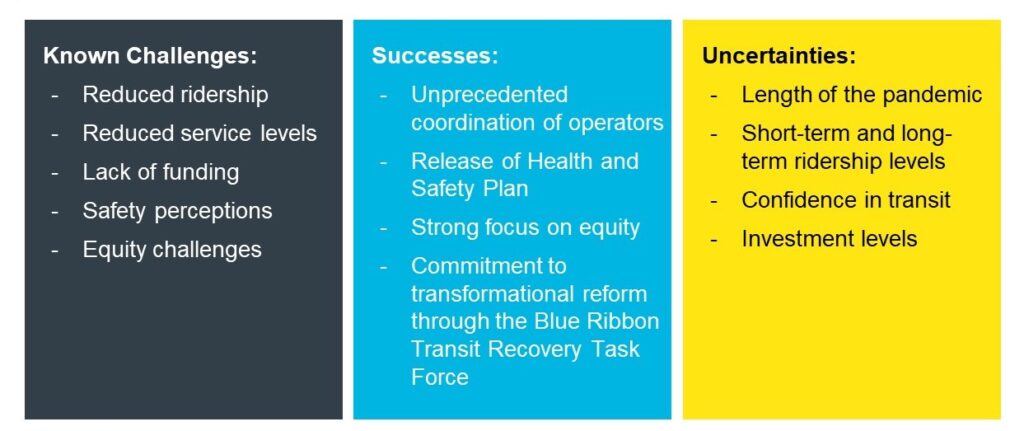
Figure 1. Summary of key Bay Area transit challenges, successes, and uncertainties that influenced the AECOM and Seamless Bay Area’s recovery vision analysis.
To support regional recovery efforts, including the recently established Blue Ribbon Transit Recovery Task Force, AECOM and Seamless Bay Area sought to better understand what a reimagined transit network could look like in the Bay Area, and what benefits it could provide. A vision for an integrated and optimized network was defined for this initiative by building upon existing transit agency long-term vision statements as shown in Figure 2.
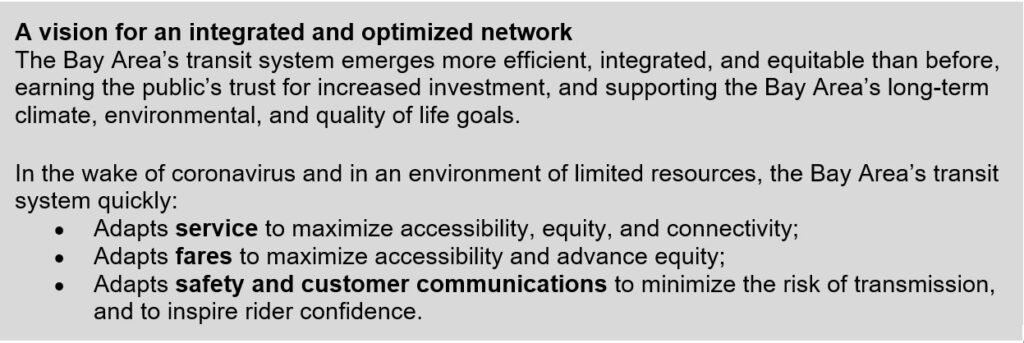
Figure 2. The network plan vision defined for this initiative builds upon and complements existing transit agency long-term vision statements.
The team developed three potential scenarios for analysis, based on varying combinations of network optimization and investment levels, and compared these to the pre-coronavirus baseline representing the “status quo” as well as to one another. These scenarios, shown in Figure 3, were then modeled with multiple factors to forecast likely future conditions, and to help forecast the effects of network optimization and investment.
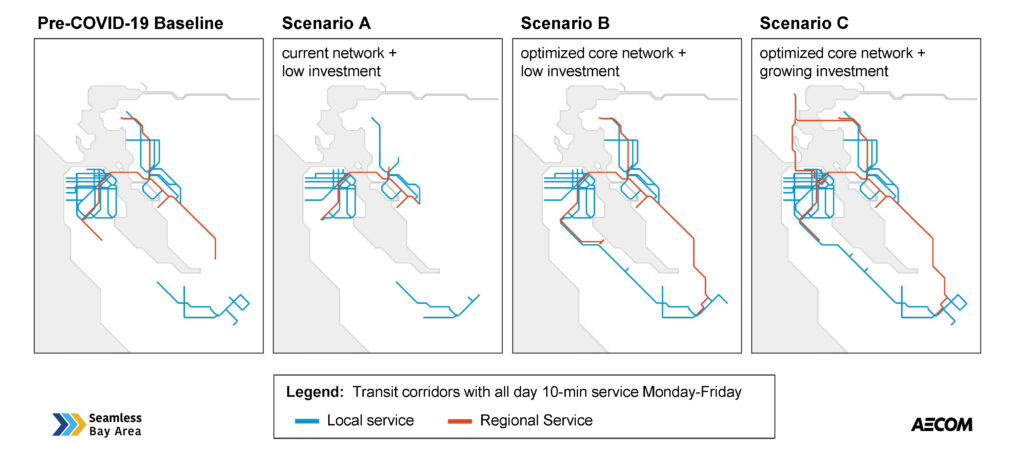
Figure 3. Scenarios B and C developed as part of the recovery vision sought to improve the extent of the frequent all-day, 10-minute network through targeted service changes. The goal was to provide greater transit accessibility to more people across the region.
The first of these scenarios (Scenario A) is based on service patterns as of June 2020 and assumes continued low investment in transit. For the alternate scenarios, the team identified a set of guiding principles for service changes with a particular focus on the preservation of service to Communities of Concern, as identified by the Metropolitan Transportation Commission (MTC), which include communities with concentrations of both minority and low-income residents, or that have a concentration of low-income residents and other disadvantage factors.[2]
Network changes were made to maintain a frequent network of trunk lines, provide greater regularity of service throughout the day, and build off of past efforts such as the megaregional rail vision developed by the San Francisco Bay Area Planning and Urban Research Association (SPUR) and AECOM, Seamless Bay Area’s Vision Map, TransForm’s ReX Vision, and the core service plans of the region’s transit operators. The result was an “optimized core network” service concept that corresponds to existing transit investment levels (Scenario B). The optimized core network is not intended to be a fully developed network plan, but rather a forecasting tool that supports collaboration and engagement among transit agencies and stakeholders at a greater scale. The team also identified how that network could be enhanced if major new sources of transit investment were approved (Scenario C).
The team estimated the potential impacts of these network permutations on accessibility to local and regional destinations, employment, and housing using geographic information systems (GIS). Additionally, AECOM’s MobiliticsTM[3] scenario planning tool was used to forecast how each network could perform under various possible economic recovery scenarios ranging from a quick 12-month coronavirus economic recovery (Economic Scenario Y), versus a more cautious 24-month economic recovery (Economic Scenario Z).
The result was a set of six future scenarios, as shown in Figure 4. The analysis yielded some significant forecast outputs for regional decision makers to consider as they chart a path towards a “better normal.”
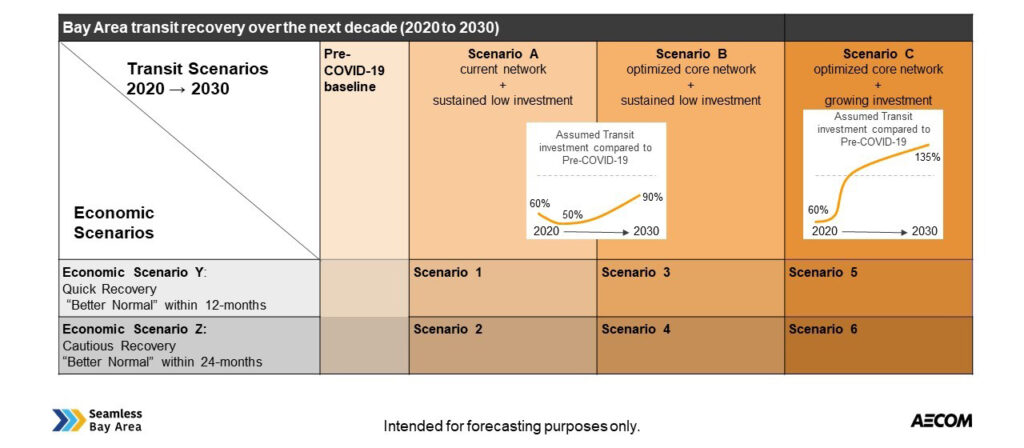
Figure 4. Summary of the three transit scenarios (A, B, and C) and two economic scenarios (Y and Z) developed as part of the Transit Recovery Vision, and the six resulting scenarios that were tested using AECOM’s scenario planning tool, Mobilitics.
As shown in Figure 5, the team developed a dashboard, in which variables can be toggled easily, to compare different scenarios, examine estimated outputs such as peak versus off-peak trips, isolate counties/districts/and degrees of Communities of Concern, and evaluate estimated accessibility by employment or household. View our video here to see a preview of this dashboard.
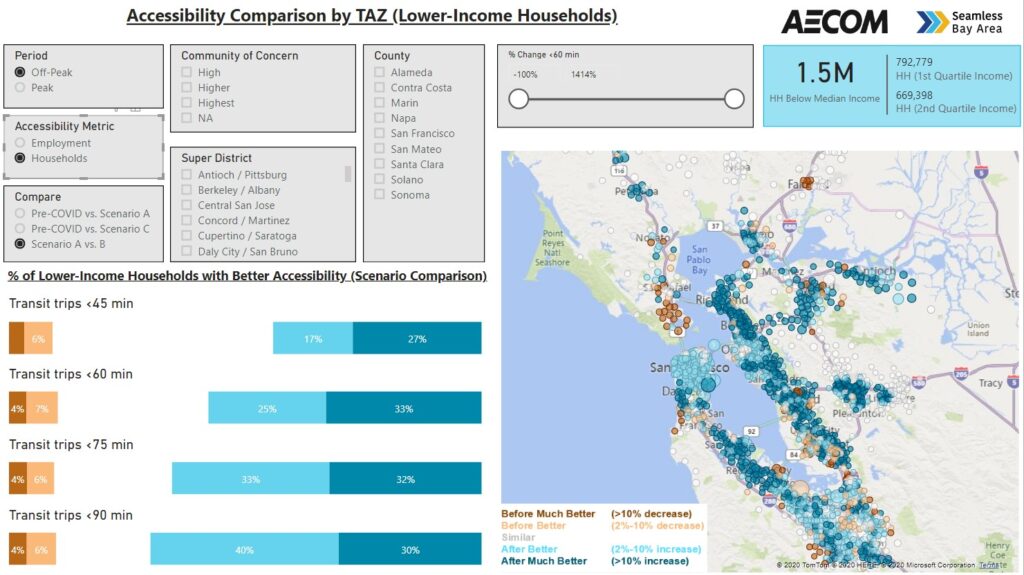
Figure 5. AECOM developed a dashboard to present estimated outputs and how accessibility to both housing and jobs could be affected by service changes, enabling isolation of specific geographies, income levels, and transit trip durations.
Forecast Outputs and Considerations:
1. The next two years are critical to regional transit success.
The Mobilitics tool forecasted that whether a quick or cautious economic recovery is assumed, the pandemic could have a long-term dampening impact on transit ridership across all scenarios that were forecasted. However, if riders do not come back to transit in pre-pandemic numbers within the next two to three years, the economic and environmental costs could be significant. The differential between Scenario A (current network, low investment) and Scenario C (optimized core network, growing investment) could be significant: the combined cost of additional roadway traffic delays (Figure 6) and added congestion could amount to approximately $860 million to $1 trillion of lost economic productivity, and approximately 155,000 to 170,000 metric tons of additional carbon dioxide equivalent/vehicle/year.
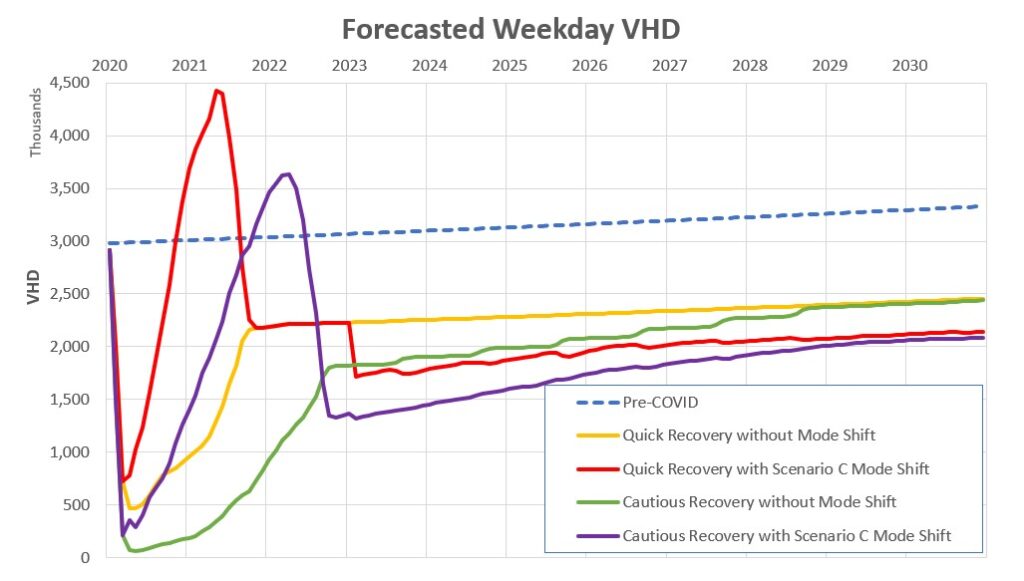
Figure 6. Mobilitics scenario planning outputs forecast that the impact of increased congestion could be most severe in the next two to three years if riders shift away from using transit, due to insufficient service or perceived lack of safety.
These forecasted outcomes based on our assumptions and possible transit scenarios underscore the importance of funding transit service throughout the pandemic to maintain service levels, alongside robust safety and customer communications programs to increase rider trust in transit and to promote faster recovery of ridership levels. Further detailed analysis will be required to fully quantify the impacts of COVID-19 on transit systems in the Bay Area in the near-, medium-, and long-term.
2. Overall accessibility can be expanded – to local and regional destinations – while keeping total service hours the same.
Our approach to network optimization deliberately held the region’s total transit operating service hours constant between Transit Scenarios A and B. This was done to forecast the potential gains that could be achieved without substantial additional funding for capital improvements or expansions, although this could require changes in agency coordination and operation cost management. For Transit Scenario B, the team modified service across the region without being restricted by existing agency boundaries or modes, to forecast what a regionwide approach to service optimization driven by regional, rider-focused goals could look like.
The forecast outputs demonstrated that net improvements to accessibility may be possible with network redesigns. Under Scenario B, the optimized network, approximately 60 percent of lower-income households could experience improved accessibility to destinations within 60 minutes compared to Scenario A, the current network. By contrast, only 10 percent of lower-income households were forecasted to have worse accessibility under Scenario B than Scenario A, while approximately 30 percent could experience no change.
3. Equitable accessibility to local and regional destinations should be a lens for making decisions on how to provide service.
The team was specifically interested in how the scenarios could impact Communities of Concern. While Scenario B was forecasted to have a net positive impact on accessibility for trips originating in the region’s Communities of Concern, some communities were forecasted to have worse accessibility due to the network optimization service changes, as shown in Figure 7.
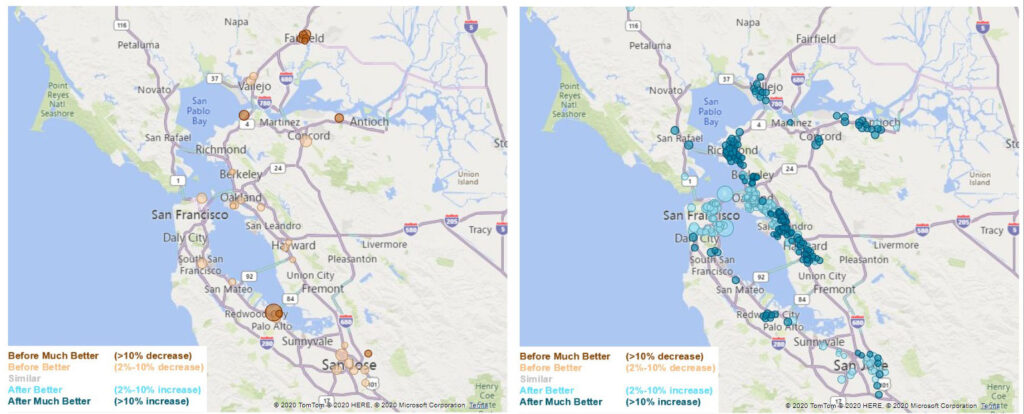
Figure 7. The GIS estimated outputs suggested that while approximately 30,000 households in Communities of Concern, or approximately 10%, (left) could have accessibility to fewer destinations within 90 minutes under Transit Scenario B (Optimized Network) compared to Transit Scenario A (June 2020 network), a much greater number – approximately 280,000 households or approximately 75% – could have accessibility to more destinations within 90 minutes in Scenario B than in Scenario A (right).
While the forecasts focused on regional impacts, a more detailed analysis of the local impacts of service changes on equity, including additional input from transit agencies and communities served, is recommended to be included in any significant network redesign. Service changes should consider not only accessibility for Communities of Concern, but also the destinations to which it is most important to maintain accessibility (e.g., hospitals, schools), and which job types should be prioritized for core network accessibility.
4. To realize the accessibility benefits of an optimized network, reduce disincentives to transfers.
The GIS and Mobilitics estimate and forecast outputs highlight the importance of streamlined transfers between transit services to maximize the accessibility benefits of the overall regional network and to make transit more appealing to elective riders. The current friction inherent in transfers among the 27 transit agencies (some with multiple transit services) could be reduced through the application of multi-agency strategies, such as more frequent service, aligned schedules at transfer points to reduce wait times, stops and stations designed to facilitate rider movement from one transit vehicle to another, and integrated fare policies to eliminate different fare structures and payment points.

Image source: Hiroko Koike, AECOM
5. Long-term funding sources need to do better than pre-coronavirus.
While the GIS estimated outputs showed that an optimized core network could provide near-term accessibility benefits, Mobilitics showed that long-term ridership recovery is forecasted to be strongly associated with overall service levels, underscoring the importance of increased funding – see Quick Recovery (Scenario C) and Cautious Recovery (Scenario C) scenarios in Figure 8. Scenario C (optimized core network + growing investment) was developed to forecast what a transformational influx of new funding – such as a new Bay Area tax measure – could mean for our transit future. Network optimization on a regional scale could make more efficient use of transit dollars, winning taxpayer confidence to maintain existing funding sources and support new tax measures.
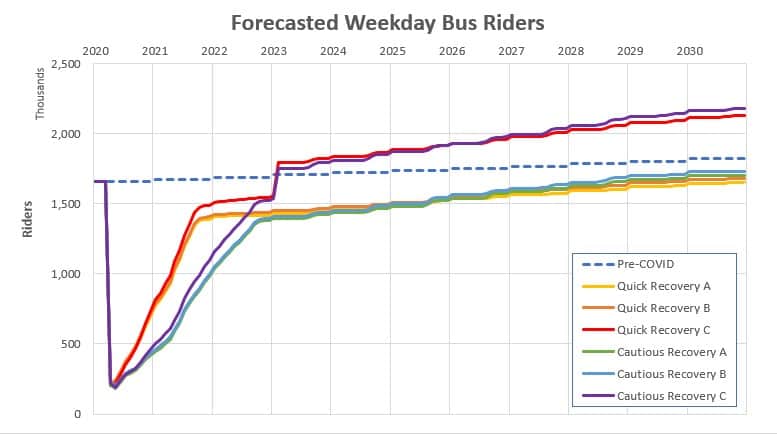
Figure 8. Over the longer term, increased investment is likely a primary determinant of increasing ridership above pre-coronavirus levels. Scenario C, assuming 135% of pre-coronavirus transit investment levels by 2030, is forecasted to result in significantly higher ridership than the other two scenarios tested (A and B), whether a quick or cautious economic recovery is assumed.
Next steps
The AECOM and Seamless Bay Area Transit Recovery Vision forecasts that a regionwide approach to service optimization and application of data analysis tools can generate forecast outputs that can help transit agencies and stakeholders make the difficult decisions that could guide Bay Area transit to recovery. On this basis, agencies, stakeholders, and decision makers can forecast possible impacts of additional scenarios and assumptions easily, as part of a comprehensive process, to work out the many details of redeploying service and regaining riders – and ultimately achieve their near-term recovery goals and long-term visions, and to realize the world-class transit system the Bay Area deserves.
To find out more, click here.
Disclaimer:
The scenario planning data in this article is intended for forecasting purposes only to demonstrate potential outcomes of proposed transit scenarios. This information should not be used to make funding decisions.
[1] http://mtc.legistar.com/gateway.aspx?M=F&ID=462e6d33-c92a-46bd-a7da-8c3fef243325.pdf
[2] Disadvantage factors include persons with limited English proficiency, zero-vehicle households, seniors aged 75 years and over, persons with one or more disability, single-parent families, and renters paying more than 50 percent of their household income on housing. Source: http://2040.planbayarea.org/sites/default/files/2017-07/Equity_Report_PBA%202040%20_7-2017.pdf
[3] Mobilitics is an AECOM trademark
is an AECOM trademark
The post Re-imagining transit service in California’s Bay Area post-coronavirus appeared first on Without Limits.
]]>The post Effective data governance: a key enabler for AI adoption appeared first on Without Limits.
]]>In the current era of big data, much ink has been spilt on the unbridled potential of Artificial Intelligence (AI) to revolutionise the construction industry. Sector focused magazines and websites are abound with organisational case studies highlighting the latest AI implementation success stories ranging from the improvement of cost prediction capabilities to enhanced abilities to detect project risks – enticing their industrial peers to jump onto this promising bandwagon.
The lure of AI is both understandable and justifiable. Within the AECOM Cost Intelligence team, our foray into this field has enabled us to improve both the quality and efficiency of our services. Our clients are becoming increasingly conscious about the potential of data to enable better prediction and enhance decision making processes. To that end, we have successfully created AI tools that perform more accurate cost predictions with much less effort compared to current processes.
Yet, despite the largely positive collective experience within and beyond our organisation, it is fair to say that the potential offered by AI remains largely untapped and this is in no small part due to the challenges related to the data quality and quantity.
The need for data
The vast majority of AI applications function by inferring trends and patterns in existing datasets before formulating predictions. As such, successful implementations of AI typically require large quantities of high-quality data to perform optimally. Deficiencies in either data quality or quantity has proven to be a significant stumbling block for AI adoption in many organisations, within and beyond the construction industry. Effective data governance holds the key for organisations to successfully navigate this hurdle.
What is data governance?
Data Management Association (DAMA) defines data governance as “the exercise of authority and control (planning, monitoring, and enforcement) over the management of data assets”. The Data Governance Institute defines data governance as “a system of decision rights and accountabilities for information-related processes, executed according to agreed-upon models which describe who can take what actions with what information, and when, under what circumstances, using what methods.” In essence, data governance concerns the deployment of the right mixture of process, technology and personnel to govern the input, storage and usage of data to achieve organisational objectives.
Data governance frameworks typically have a wide reach and could vary based on organisational needs. That said, there are several key aspects that are commonly present across most data governance frameworks (see Figure 1):
- Stewardship: Promoting accountability by assigning stewards/custodians to relevant datasets
- Accessibility: Facilitating availability of data for relevant stakeholders
- Data Security: Ensuring sensitivity-based safeguarding measures are implemented on databases
- Data Quality: Maintaining and monitoring data quality to ensure its suitability for intended applications
- Knowledge: Preserving and improving data knowledge within the organisation by ensuring documentation of data systems and related processes are kept up to date.
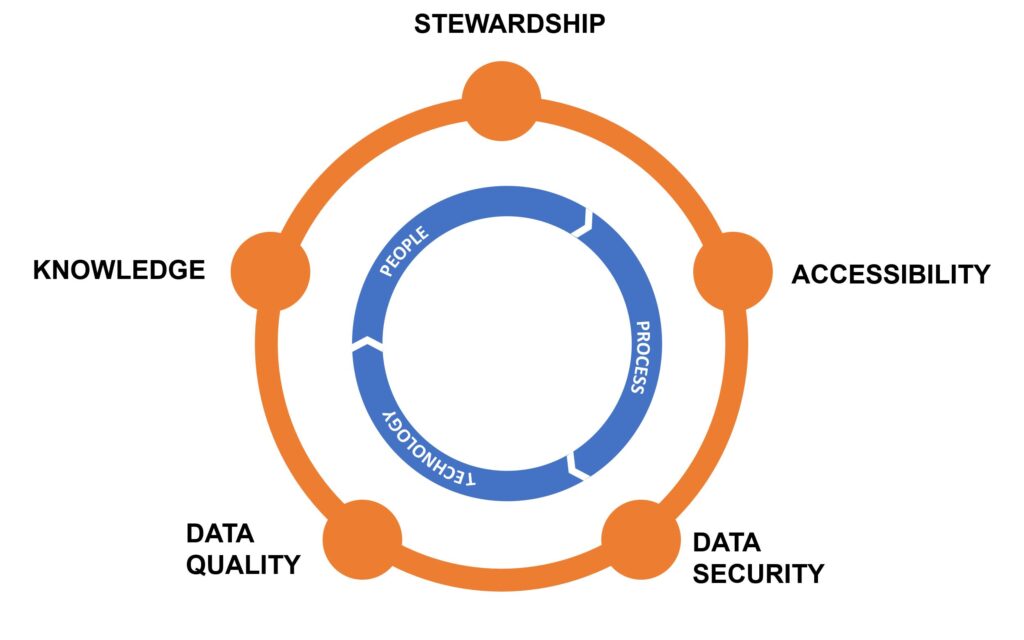
How is data governance relevant to AI?
While data governance facilitates the implementation of AI through various aspects, the most critical contribution is its facilitation of high-quality data collection. This is achieved through various means; most critically through its emphasis on data quality.
An effective data governance framework emphasises data quality by defining data quality requirements and monitoring this requirement against relevant metrics. This function is bolstered through the identification data stewards to promote accountability and encourage initiative amongst stakeholders to maintain the quality of data to the required standards. By pursuing this, the burden of maintaining data quality can be shared across many actors – particularly amongst those upstream of the data pipeline. The focus on knowledge capture and transfer, on the other hand, ensures that members are kept abreast with the data needs of the organisation while also maintaining consistency in the organisation’s practice by assuring continuity in the face of personnel changes.
What are other benefits of data governance?
Data governance is pivotal in aiding organisations to achieve a myriad of other objectives besides AI adoption. This framework has been pivotal for many financial institutions to achieve regulatory compliance. Further, effective data governance frameworks enable organisations to standardise various business processes and improve operational efficiency. From an asset management perspective, the implementation of a robust data governance framework is critical to ensure compliance with ISO 55001 by enabling processes and systems to satisfy the data requirements outlined by this standard. Further, by emphasising data quality across all levels of an organisation, data governance facilitates data-driven decision-making with or without AI implementation.
Who is responsible for data governance?
As with most critical business functions, data governance requires collective effort for successful implementation. That said, buy-in and direction from the leaders of an organisation is critical to ensure that this process is in line with wider business objectives and strategy. Further, a top-down intervention is pivotal to ensure data governance related tasks are afforded the requisite prioritisation amongst other BAU activities. By promoting data consciousness at the top of the organisation, it will be easier to shape the right culture. Only by doing this, can the benefits offered by AI be sustainably leveraged.
How can we help?
We work extensively on various facets of data governance with our clients across the built environment sector. We have helped our clients improve their data pipeline and systems across our diverse portfolio of projects. Our combination of technical, organisational and commercial skills enables us to work with different stakeholders across organisations on a wide variety of projects ranging from the deployment of data systems to the formulation of organisational data strategies.
We have also developed a standardised data quality assessment framework based on recognised industry standards. As data quality is a key tenet of data governance, this framework has facilitated the adoption of best practice to enable our clients to achieve their data governance objectives.
Further, with our knowledge of AI we actively assist our clients in reshaping their data processes and systems in accordance with AI system requirements; enabling our clients to fully leverage the potential AI has to offer for their organisation.
This is the second in a series of articles on data management and governance authored by AECOM’s data science and digital experts. To read the others, please click here and here, or visit our Innovation & Digital hub here.
The post Effective data governance: a key enabler for AI adoption appeared first on Without Limits.
]]>The post Going underground: untapped land uses beneath our feet appeared first on Without Limits.
]]>While Hong Kong has a long history of using underground space for commercial and public facilities, many of these projects were simply an extension of the building on top of them, with limited connection to the city around them. As urbanization continues its upward trend and our perceptions of space — personal and public — are constantly evolving, this use of layered technologies to explore the underground holds the potential to revolutionize urban liveability and create synergies with the surrounding urban context.
AECOM, commissioned by the Civil Engineering and Development Department (CEDD) of the Hong Kong Special Administrative Region (HKSAR) Government to undertake a study of underground development in an urban space, has explored ways of integrating the latest innovative technologies, including Virtual Reality (VR) and photogrammetry technologies with more widely used techniques in the industry, such as Building Information Modeling (BIM) and 3D spatial data to improve communication among the different parties involved in the planning and design process of underground space.
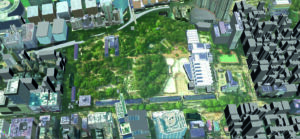
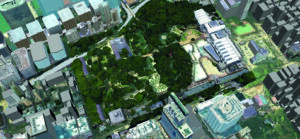
This novel combination of technologies has resulted in time savings, increased efficiency and cost benefits as well as greatly enhanced cooperation and the ability to virtually collaborate without the need for travel to a project site. On one project, outlined below, the use of photogrammetry technology to create a 3D model of the existing site saved three weeks time from the site survey, while sharing the site reality model with the designer for performing the parametric design saved another two weeks. Integrating various feature models into a visualization model for the Virtual Reality simulation saved another two weeks by amalgamating information to form a holistic review with different parties. Further, it saved client comment time as 3D visualizations facilitate the design detail and constraints of the project. Since the design team did not need to travel to Hong Kong, this saved around $100K HKD.
Particularly in high density cities, where land value is high and greenfield developments are hard to come by, the ability to map the underground more effectively and efficiently may open a world of possibilities.
This combination of technologies was first used to see how an urban park in Honk Kong that is close to a railway station could be better integrated to its surrounding area. The park is surrounded by densely developed multi-story buildings of mixed residential, commercial and retail use. For initial planning, AECOM and CEDD wanted to capture the existing environment in a 3D model to study how the park related to a wide range of facilities at ground level. But while there was 3D data on the buildings surrounding the park, there wasn’t any available 3D data on the park itself. That’s when we started going underground.
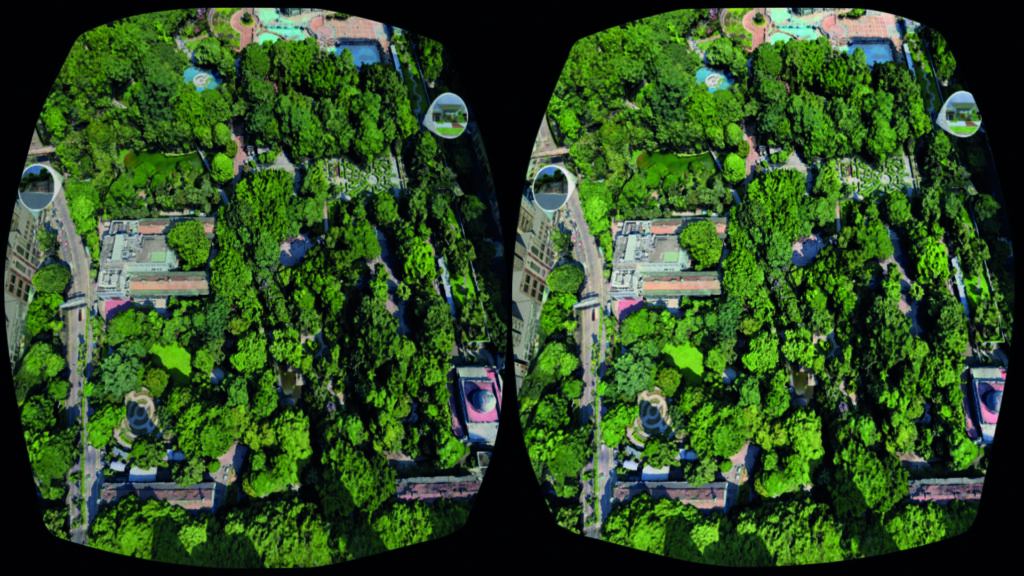
To build a more complete picture, we used Hong Kong government 3D spatial data[1] from the Lands Department to create that 3D model of the park then combined it with aerial photogrammetry technology. We shared the resulting model – complete with hard and soft landscaping and areas of interest within the park – with our partnering architecture design company based in Japan who had enough detail to be able to do many things that would usually have required travel to Hong Kong. This included measuring the space, seeing the topographic setting and the detail of the proposed site, as well as gaining an understanding of how the underground project would relate to the existing environment.
In the early stages of the design, a BIM model was created using the architectural design model which allowed all parties involved to communicate effectively and with a great level of detail. The BIM model was then combined with the site reality model (3D + photogrammetry) to create a Virtual Reality (VR) model that could be experienced on a computer screen. This virtual environment gave designers, planners, engineers, consultants and client representatives a realistic and life-sized place to walk and talk through the various aspects of the project.
After we layered on the virtual reality component, the resulting 1:1 representation of the project site also enabled 360-degree panoramas suitable for mobile VR devices used at in-person public consultations, as several mobile devices can be deployed at one venue. Panoramas can also be hosted on a website to reach a wider audience. The next level we’re exploring is a computer-connected VR device which would allow for more detailed design review and for users to interact with the virtual underground space design at a real-world scale. These representations could also be used in a virtual consultation room using AECOM’s interactive web-based tool.
Another benefit to this layering of technologies is that visualization models are not limited to the illustration of design details; data can be converted to other software to view shadow, noise and traffic impact assessments; 4D (BIM) simulation can also help to visualize the construction process.
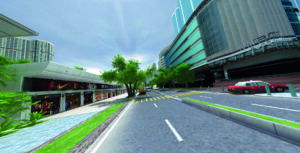
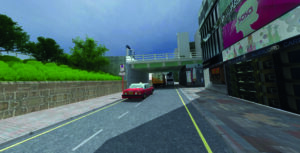
This approach is unique because the novel integration of these innovative technologies has rarely been investigated within the framework of a single project and never-before used to explore underground space. Stakeholders often think only of BIM, but with an open mind this concept can be (and has been) replicated with different combinations of the various available technologies to suit the needs of other clients and projects.
Our study demonstrates the clear benefits for all parties involved in the planning and design of the conceptual scheme for underground space development in densely populated urban areas. Designers, planners, clients and consultants can visualize the components of a design at a 1:1 scale in ways that cannot be matched by 2D or 3D software alone. For the public, the realistic nature of the VR-based model brings the project and its full potential to life.
Learn more about this and other explorations of the potential of subterranean space to revolutionize the future urban experience in the new book Underground Cities: New Frontiers in Urban Living, introduced here.
AECOM would like to acknowledge the Head of Geotechnical Engineering Office and the Director of the Civil Engineering and Development Department, the Government of the Hong Kong Special Administrative Region, for the permission to publish. The usage of material was authorized by ACUUS, the Associated Research Centers for the Urban Underground Space. The Government of the Hong Kong Special Administrative Region does not accept responsibility for the accuracy, completeness or up-to-date nature of any reproduced versions of the material concern.
Unless otherwise indicated, the photographs found in this article are subject to copyright owned by the Civil Engineering and Development Department (CEDD). Prior written consent is required for a third party who intends to reproduce, distribute, display or otherwise use such photographs in any way or for any purpose. Such request for consent shall be addressed to the CEDD via email at enquiry@cedd.gov.hk
[1] 3D Spatial Data is a set of territory-wide digital 3D model data created to represent the shape, appearance and position of various types of ground features including building, infrastructure and terrain.
The post Going underground: untapped land uses beneath our feet appeared first on Without Limits.
]]>